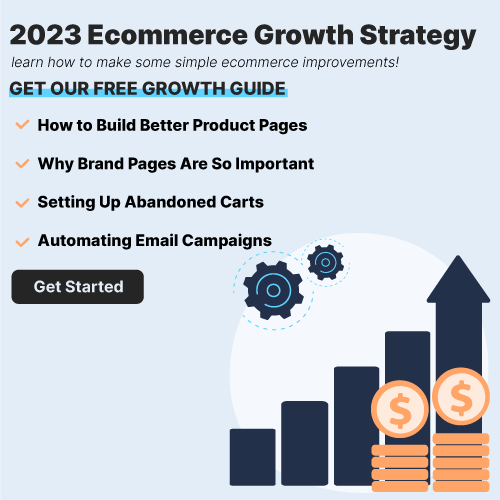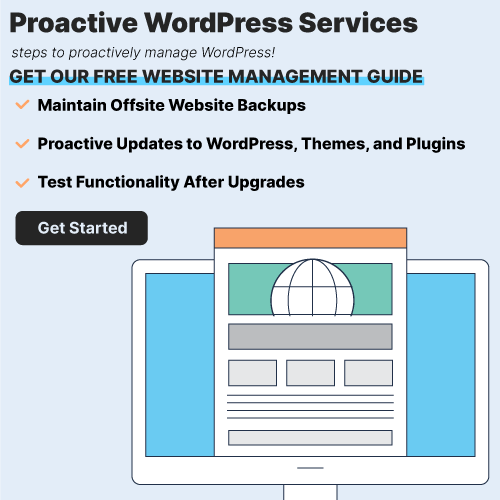Hello, coffee enthusiasts! Want to learn about the world’s best coffee companies and explore the world of coffee like never before? Our guide to the top 49 coffee websites is here to help.
Our team of online marketers has scoured the web to find and evaluate the best coffee sites based on design, functionality, uniqueness, and user experience. From visually stunning designs to in-depth knowledge on coffee, these sites embody excellence in the coffee world.
Not only will you find inspiration for your own coffee website, but also gain valuable tips on how to create an online presence that showcases your passion and expertise in the world of coffee.
Explore the world of coffee and create an online presence that reflects the unique flavors and aroma of your coffee business! You’ll find website examples of coffee roasters, coffee shops & cafes, coffee distributors, online coffee retailers, and coffee equipment manufacturers in this list! For examples within other industries, head back to our great website designs article!
Top Coffee Company Website Designs
1. Quills Coffee
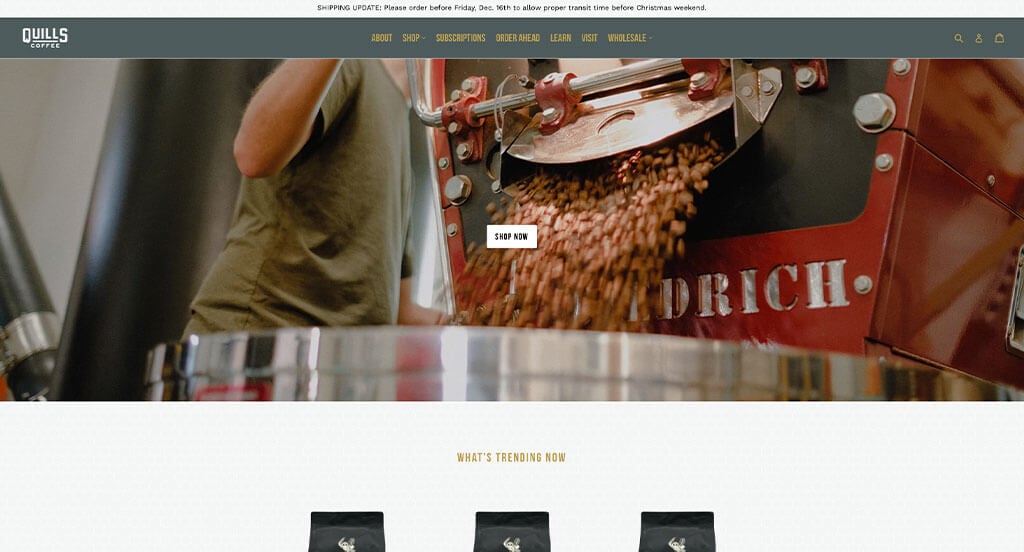
The Quills Coffee website has a very classy feel to it, thanks to its blended use of black, white and green. We thought this was a good homepage design example for coffee stores because of the accented green that wasn’t overpowering. Another design quality in this clean coffee website we liked was the addition of a search bar. They clearly had conversions in mind when building the buttons for simple navigation throughout their website. Any website designer building websites for coffee sellers will want to consider checking this website out.
2. Republic of Pie
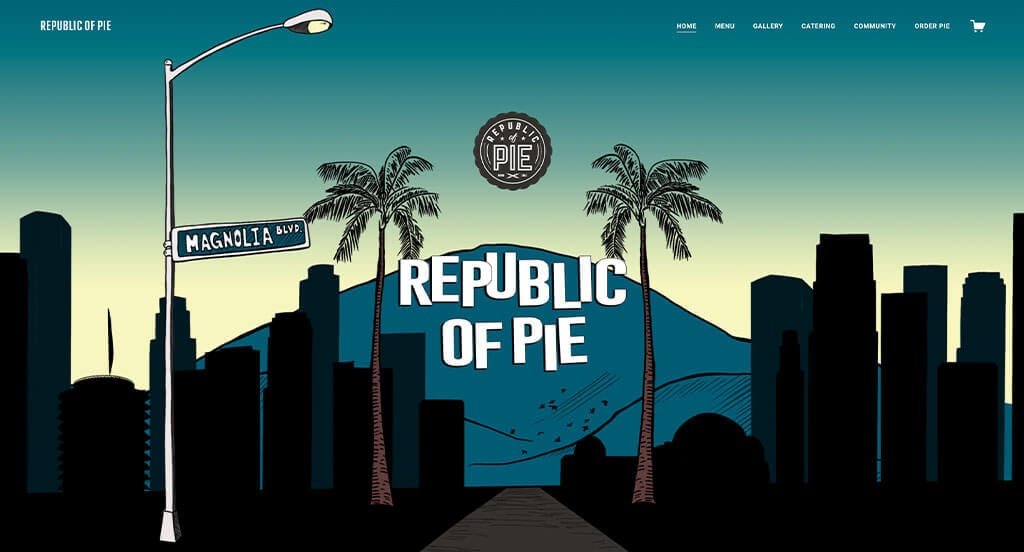
This is a good example of a coffee shop website design for someone who is searching for a professional website design idea. One of the design features we liked most on the homepage of Republic of Pie was their variety of products because that isn’t something you find on most coffee seller websites. This creative coffee shop site also does a good job with their simple checkout process. They clearly had website marketing in mind when designing the creative logo design for their company. There was no shortage of reasons to include this website in our list of websites for coffee shops to consider when designing their next website.
3. Art Cafe
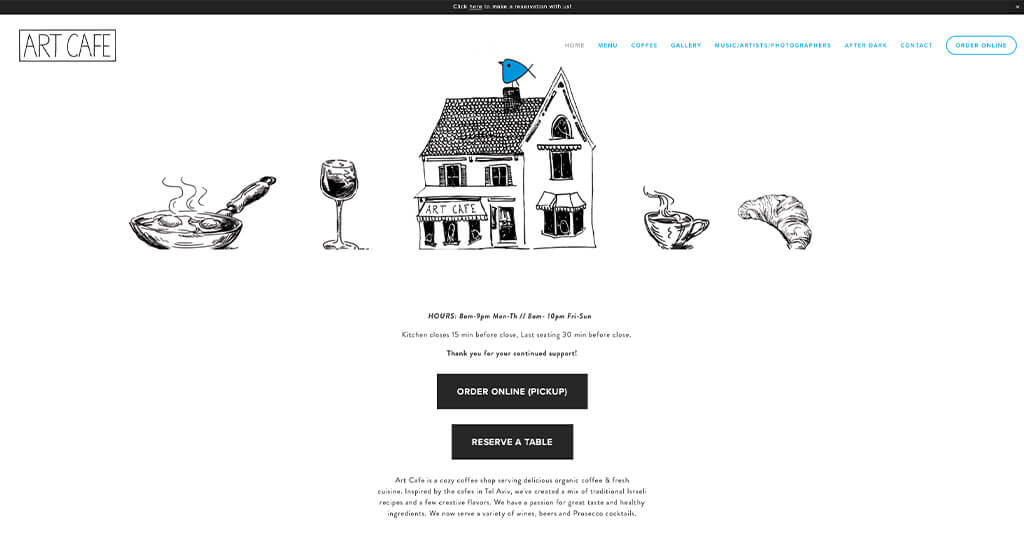
The black, white and blue color palette of this custom coffee store website stood out to us because it creates a simplistic design. After scrolling past the navigation of this coffee shop website, you’ll notice their thoughtful graphics. Their incorporation of a video was another unique quality in this professional cafe site we enjoyed. Art Cafe clearly had a focus on ease of use when creating the photo gallery for their food and drinks. Be sure to consider the one-of-a-kind design of this coffee shop website when developing your next custom website.
4. Black Bird Cafe
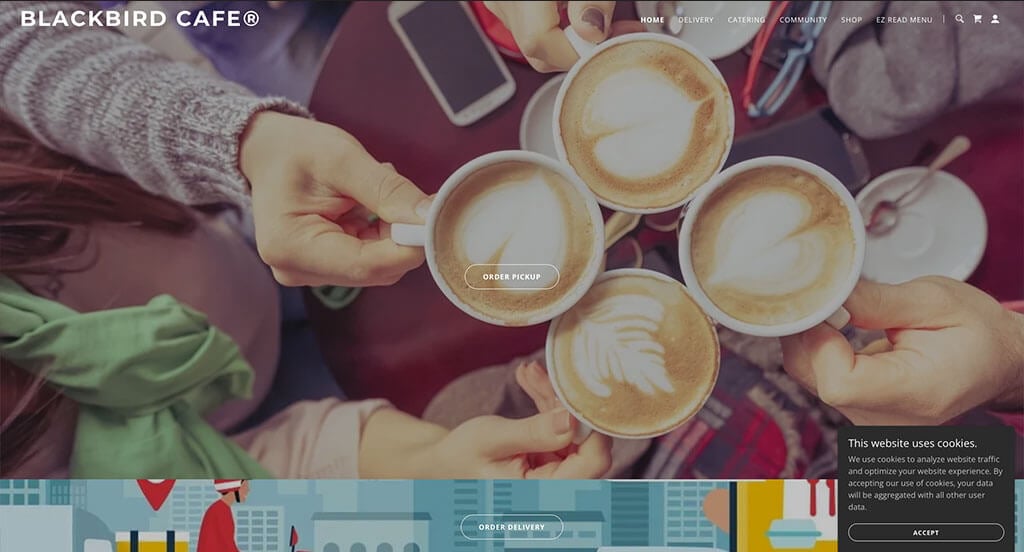
There were numerous coffee shop websites to choose from, but the website for Blackbird Cafe was the perfect example of a well-designed site with a monochrome color scheme. One of the homepage features of Blackbird Cafe we noticed was their use of many different images for backgrounds. Their well-labeled navigation bar was refreshing for a custom site. From a marketing point of view, we really liked the way this coffee store website utilized a page on their site for their contact information. For the cafes out there checking website examples, make sure to check this one out!
Related: Drive traffic to your local coffee shop with digital marketing campaigns!
5. Regent Coffee
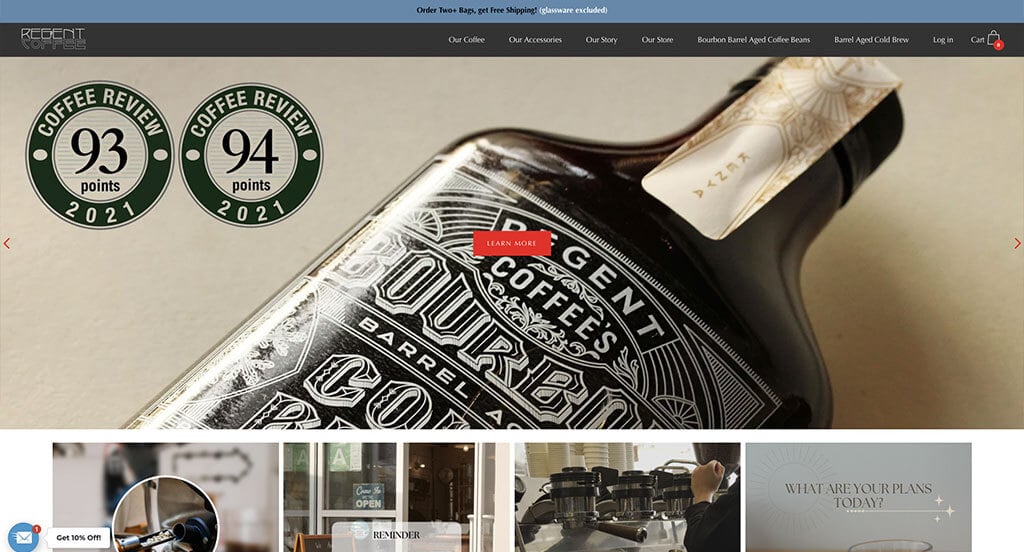
This is a good example of a website design for cafes who are looking for a professional look and feel for their next site. Of all the professional coffee websites we reviewed, one of the features in this custom website we liked was their textured panels for their background. Their clearly labeled pricing was definitely refreshing for a professional website. Regent Coffee clearly had website marketing in mind when building the journal for their website. Don’t forget to check this website out while looking through our list of the best coffee store sites!
6. Colectivo Coffee
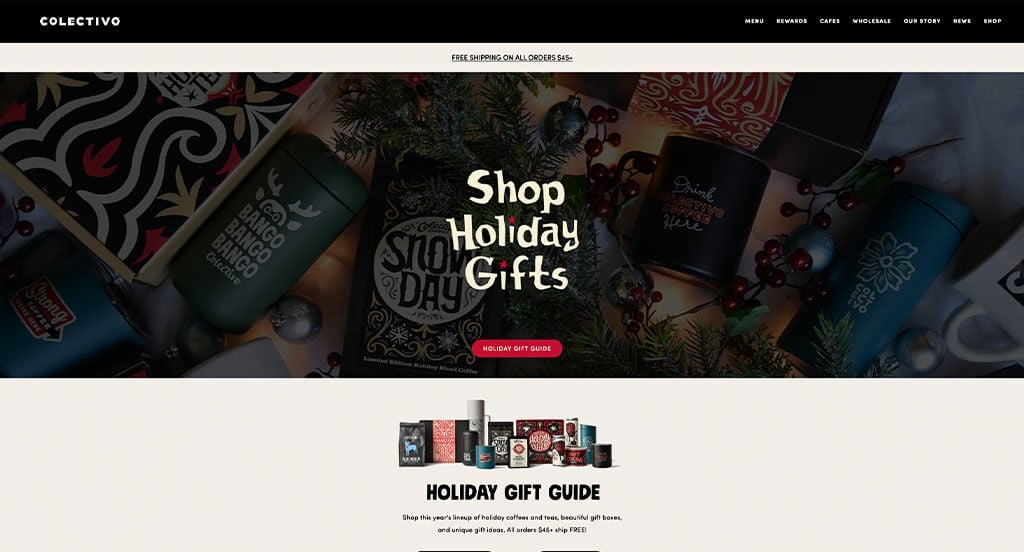
This is a great website design example for coffee stores to check out when looking for a custom look and feel. We thought this website was a good example for coffee shop because of their captivating font. Another design quality in this professional coffee site we liked was the creative graphics. Colectivo clearly had a focus on conversions when designing the information about their locations but also their online store. What a great website to review when building out your next website!
7. Sightglass Coffee
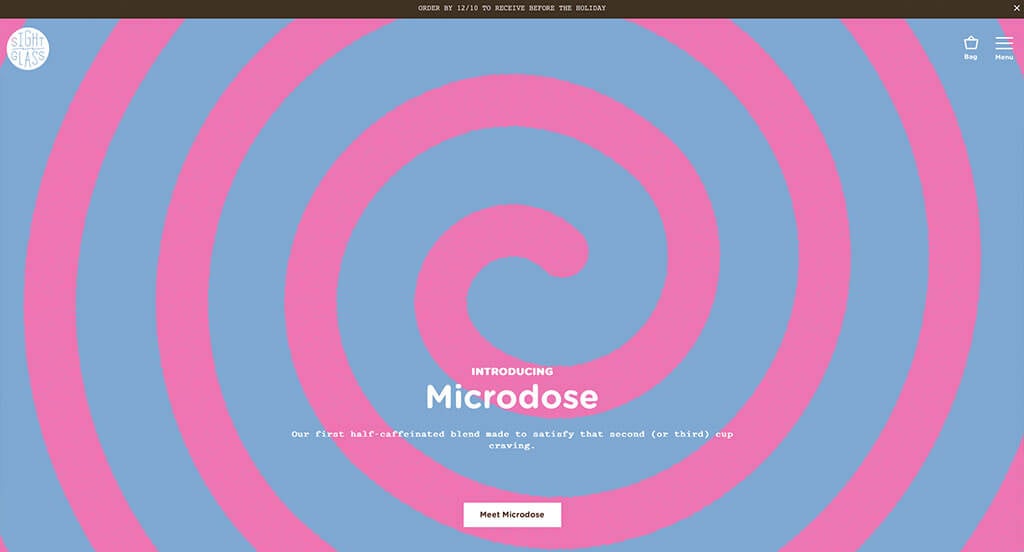
The white, brown, gray and blue colors seen in this coffee website stood out to us because it feels simple and relaxing. One of the homepage features in Sightglass Coffee we noticed was their 5-star rating system for their products because that isn’t something you find on most Coffee websites. Their thoughtful quiz to help you find your coffee match was definitely refreshing for a professional website. Sightglass Coffee clearly had website usability in mind when incorporating social media into their website. Give some thought to the unique design of this coffee shop website when building out your next website.
8. Meno Tea & Coffee

We liked how this coffee site used a simplistic color scheme to create an attractive website design. Our web designers thought this was a good homepage design example for coffee websites because of their simplistic template that was easy to navigate. The high-quality visuals was another feature in this custom coffee and tea site we enjoyed. Meno Coffee & Tea had digital marketing in mind when building the graphics that enhanced the site. There was no shortage of reasons to include this website in our list of websites for coffee shops to consider when designing their next website.
9. Stumptown Coffee Roasters
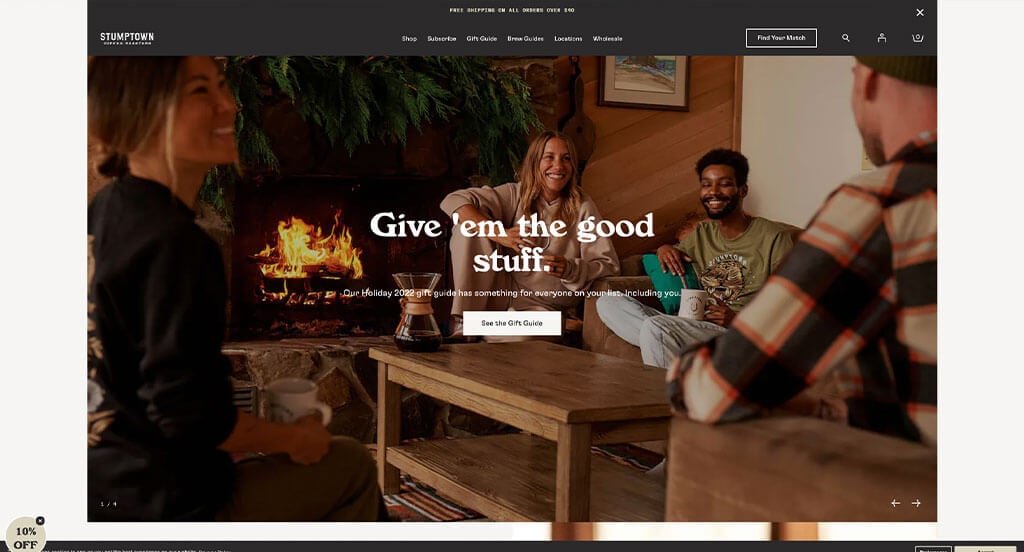
This is a good example of a website for a coffee store to take a look at when searching for custom web design layout ideas. The stunning layout was probably the most impactful quality in the homepage of this website. The simple checkout process was definitely refreshing for a custom coffee shop website. Stumptown Coffee Roasters clearly had website marketing in mind when building the unique gift guide page in their website. If you are looking for template examples for your next coffee site, be sure to check this one out.
10. Cafe Patachou
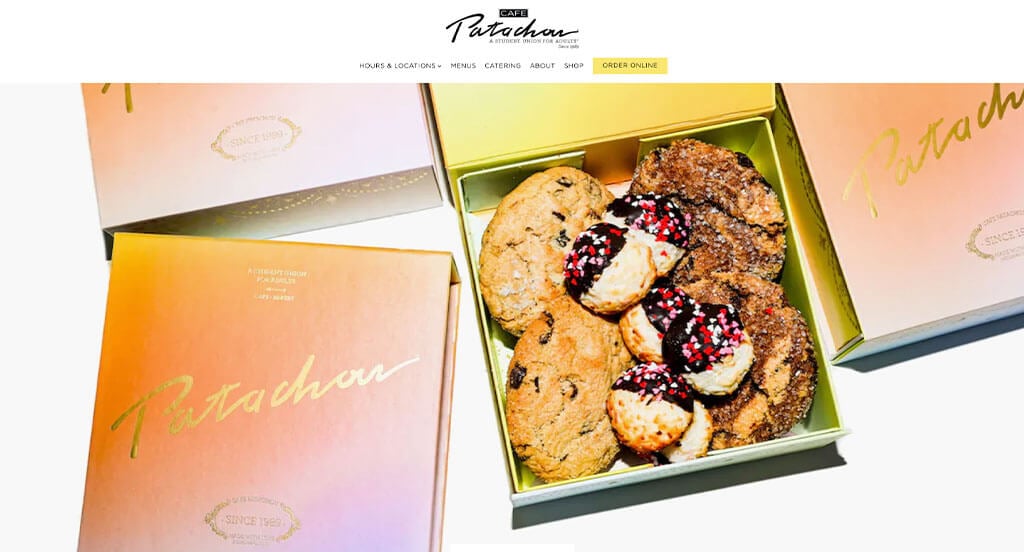
This is a great coffee shop web design example for someone who is looking to develop a professional website. We thought this website was a good design idea for coffee stores because of their unique patterns used throughout the page. Their use of buttons for simple navigation throughout their site was another design quality in this custom coffee shop site we enjoyed. Cafe Patachou clearly had internet marketing in mind when building the domain for their website that matches their company’s name. Any website designer mocking up websites for coffee sellers will want to consider checking this website out.
11. Roast Works Coffee Co.
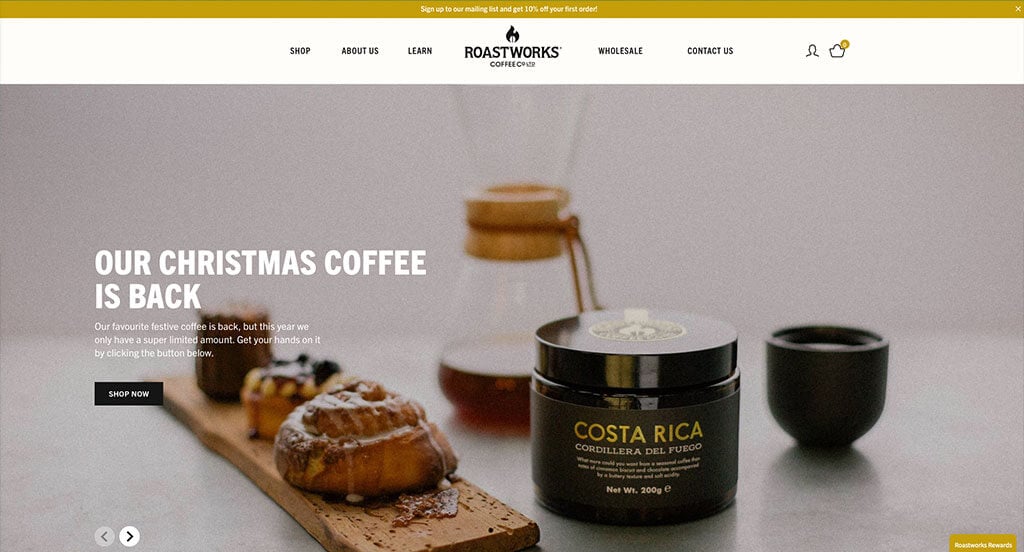
Roast Works Coffee Co. has a great looking website that uses a black, white and yellow color scheme. The simplistic logo design was definitely the most impactful feature in the homepage of Roast Works Coffee Co. Another thoughtful quality about this professional coffee shop website was their coffee that was native to different areas of the world. From a marketing point of view, we liked the way they utilized a navigation bar with organized categories. Give some thought to the one-of-a-kind design of this coffee store website when building your next website.
12. Grit Coffee Roasting Co.
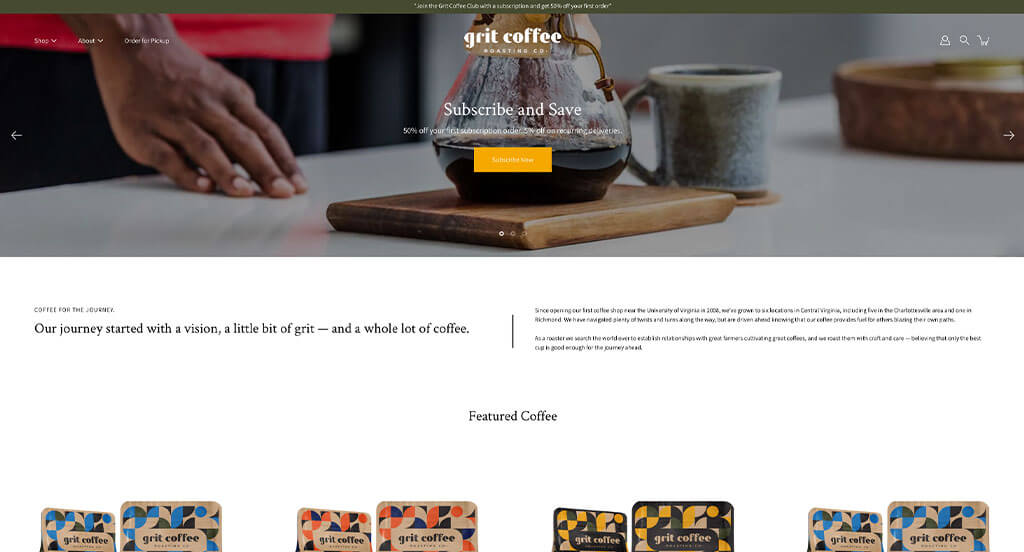
This is a good example of a website for a coffee shop to check out when looking for custom web design layout ideas. The sections that allow you to see everything they sell on a simplified level was likely the most impactful quality in the homepage of this website. The creative patterns on their coffee packages was another feature in this custom coffee store site we enjoyed. Grit Coffee Roasting Co. had internet marketing in mind when designing the professional font for their website. You won’t be disappointed after reviewing this website for design ideas for your next website!
13. Tiago Coffee
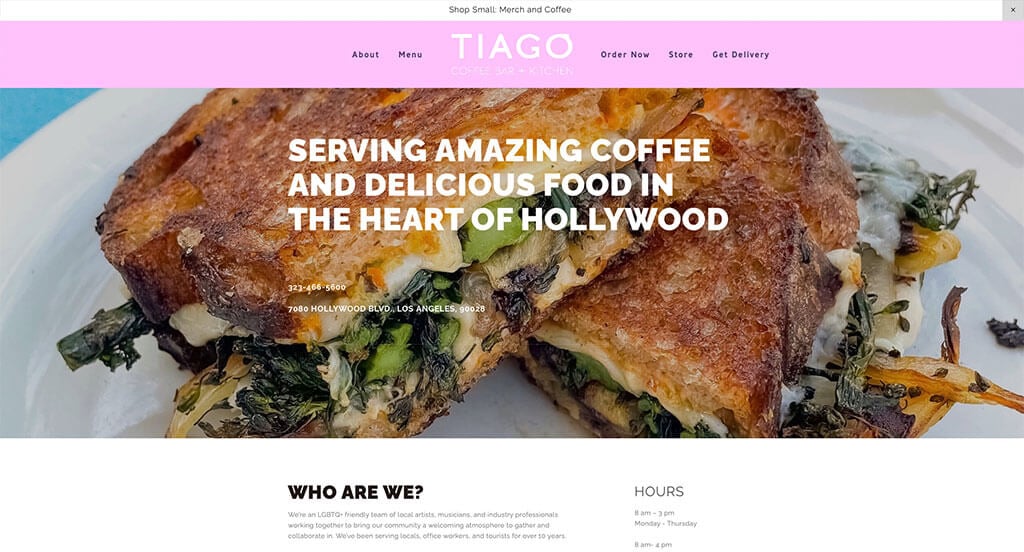
Tiago has a great looking website that uses a pink, purple, white and black color scheme, which we like because it creates a youthful feel. The bold font to emphasize the titles was probably the most impactful quality in the homepage of Tiago. Their professional looking menu for their shop was a nice touch for a professional website. They clearly had a focus on conversions when building the simplistic template for their website. With so many great reasons to consider this coffee shop website, it’s obvious why we included it in this list of the best websites!
14. Tofino Coffee Roasting Company
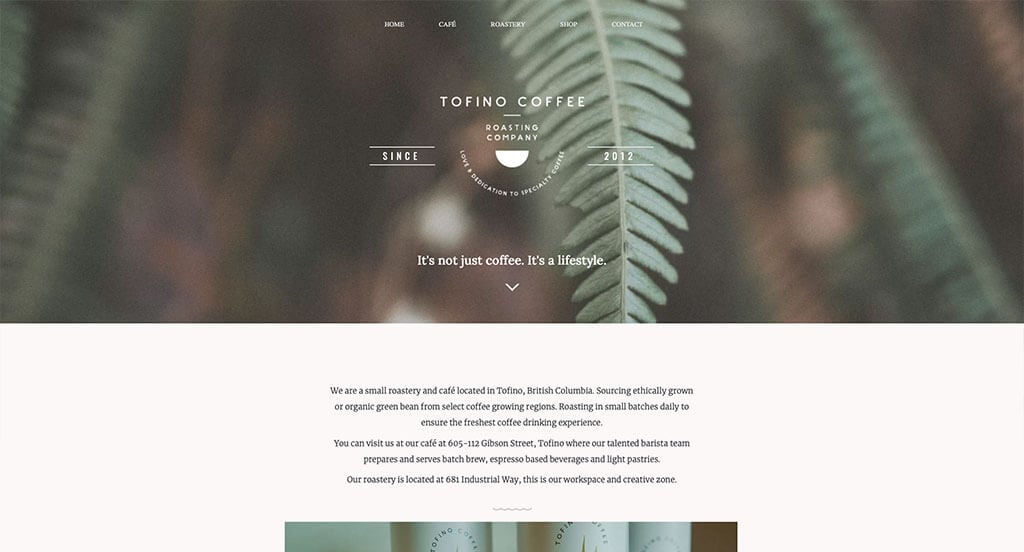
This is a good example of a coffee shop website design to see when looking for a professional website layout idea. After scrolling past the navigation of this coffee store website, you’ll immediately notice their large imagery. Another feature in this professional coffee site we enjoyed was their aesthetically pleasing template. Tofino Coffee Roasting Company clearly had website usability in mind when building the clearly labeled pricing within their website. These were just a few of the qualities of this website we had to consider when we were putting together this list of top websites for coffee shops.
15. Greater Goods Roasting
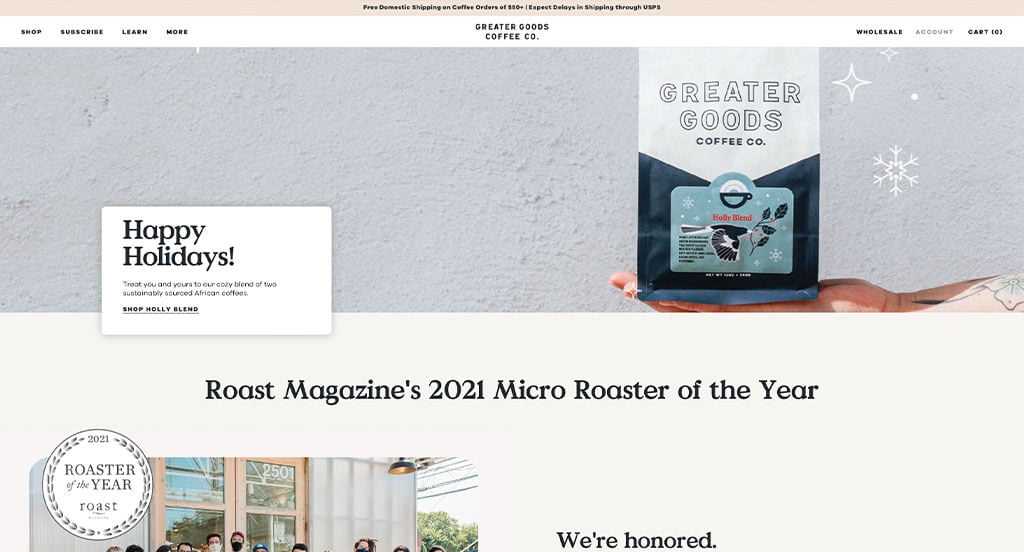
Showcasing a clean and intuitive layout, this website keeps things simple for a coffee seller site. Our web designers thought this website was a good design idea for coffee stores because of their high-quality visuals. Another design quality in this professional coffee shop site we noticed was their layout with a good balance of white space. The incorporation of an informational blog helped make this one of the best coffee websites we looked at. Be sure to consider the great design of this coffee seller website when developing your next custom website.
Related: Run paid advertising to help drive awareness and traffic to your coffee website!
16. Parakeet Cafe
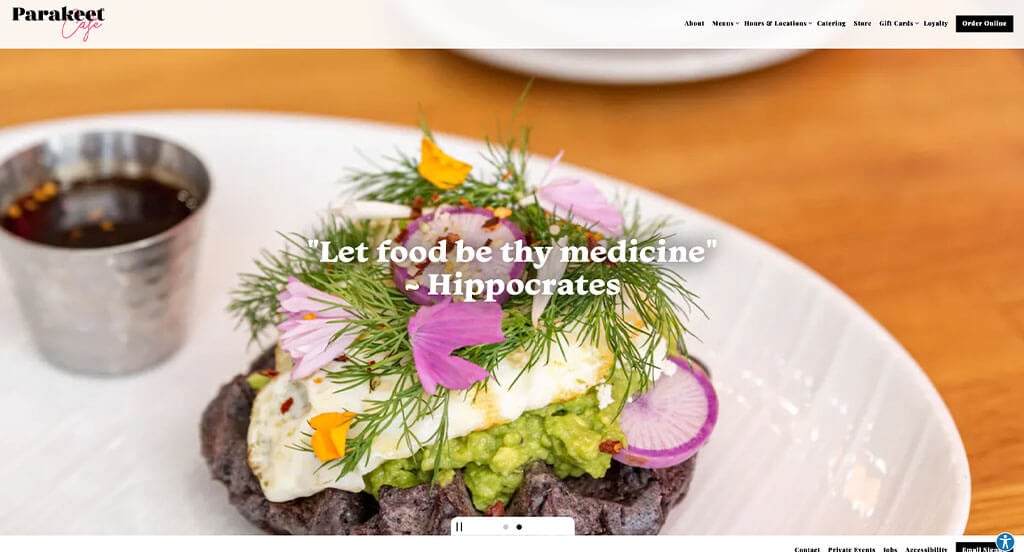
We appreciated how this cafe site used the colors of black, white and pink to create an attractive website design. The staggered design for their images was definitely the most impactful quality in the homepage of Parakeet Cafe. Another design quality in this professional coffee website we liked was their use of buttons for simple navigation throughout their website. They clearly had website usability in mind when building the domain for their website that matches their company’s name of their website. Don’t forget to check this website out while looking through our list of the best coffee shop website layouts!
17. Ceremony Coffee Roasters
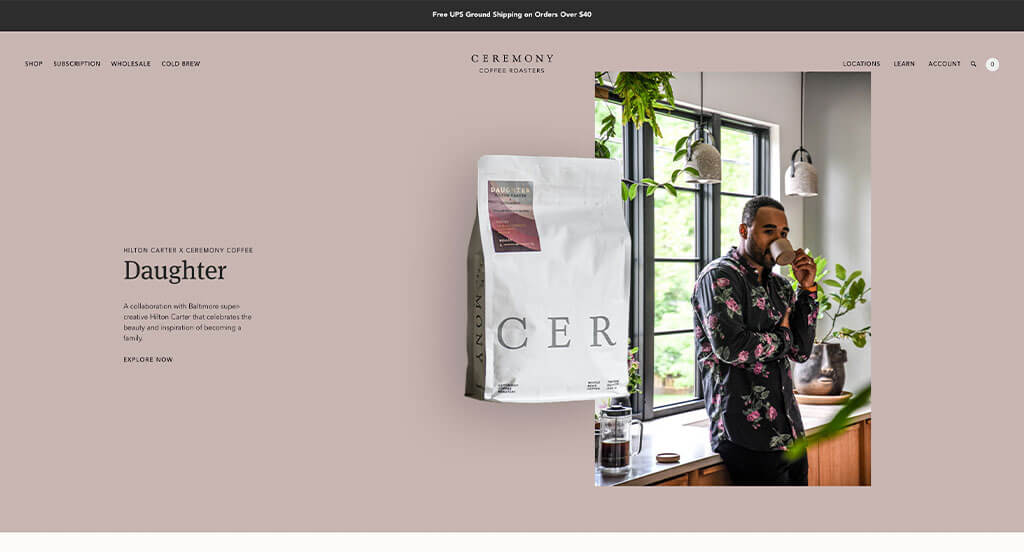
This is a great website design example for coffee stores who are looking for a custom layout. After scrolling past the header of this coffee shop website, you’ll immediately notice their unique color palette. Their incorporation of social media was a nice touch for a unique site. From a marketing perspective, we liked the way this coffee website utilized a clearly labeled menu. Don’t scroll past this website when considering design ideas for your next coffee store website!
18. Black Fox Coffee Co.
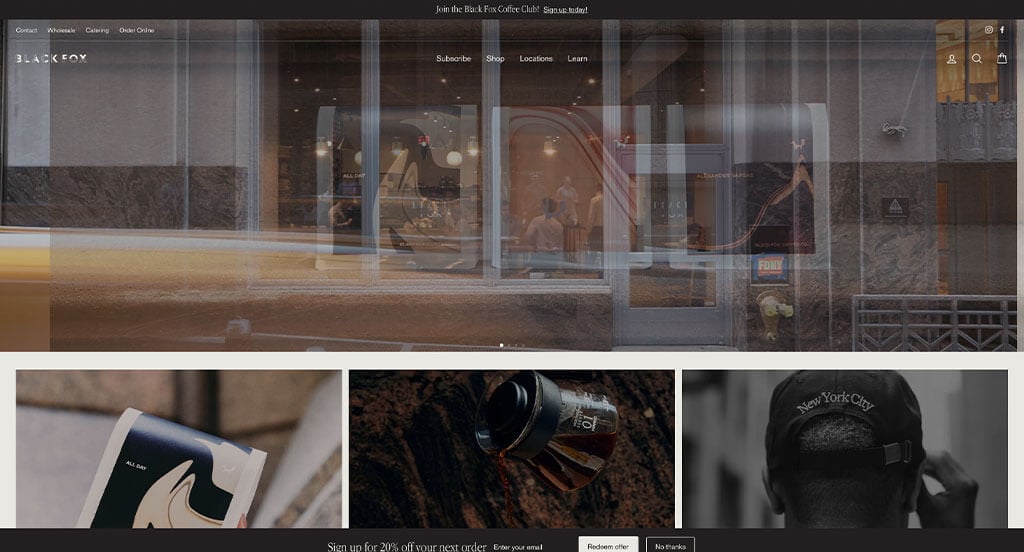
This is a great web design example for coffee sellers who are looking for a professional look and feel. The most attention grabbing aspect in this coffee shop website was definitely their use of buttons to enhance usability. The logical structure to their content was absolutely a consideration when ranking Black Fox Coffee Co. in this list of the most professional coffee store websites. Black Fox Coffee Co. had digital marketing in mind when designing the simple checkout process for their website. If you are looking for template ideas for your next coffee site, give some thought to this one.
19. Interstellar
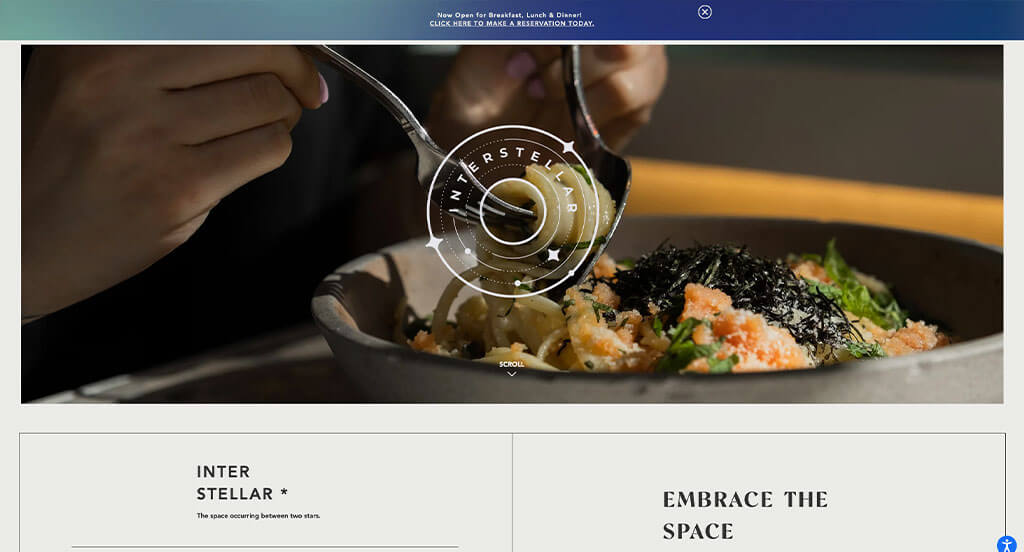
We appreciated how this coffee shop site used the colors of black and white to create an attractive website design. The part of this website’s homepage that caught our attention was definitely their thoughtful graphics. The addition of a merchandise line was refreshing for a professional site. They clearly had a focus on internet marketing when designing the captivating template for their website. Give some thought to the unique design of this cafe website when developing your next custom website.
20. Cafe Britt
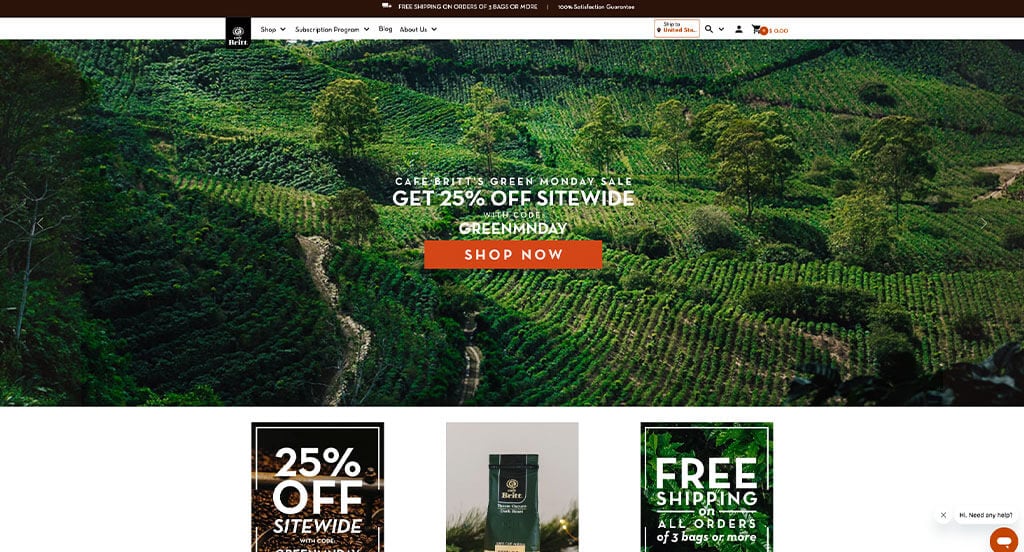
This is a great website design example for a coffee seller to check out when looking for inspiration on a custom look and feel for their next site. The customer review section was probably the most impactful feature in the homepage of this website. The use of brightly colored buttons was refreshing for a professional coffee shop website. They clearly had a focus on internet marketing when designing the domain for their website that matches their company name. For coffee stores looking for ideas on their next website, this example will definitely be one to keep in mind.
21. Culture Espresso
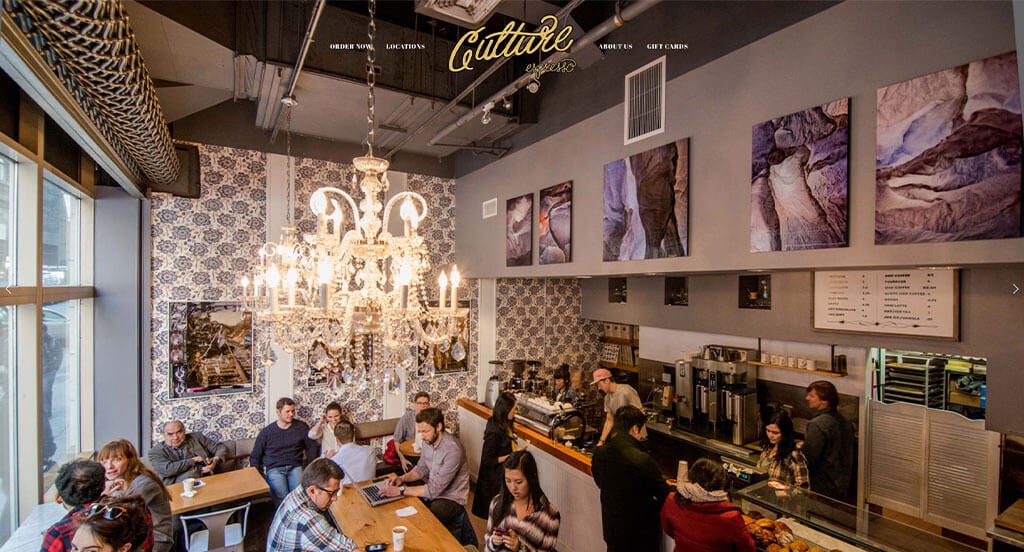
This is a good example of a website design for coffee shops to review when looking for a professional look and feel. The unique graphics were probably the most impactful quality in the homepage of Culture Espresso. The incorporation of social media was a nice touch for a custom site. They clearly had a focus on ease of use when designing the template that was easy to navigate. Be sure to consider the unique design of this coffee website when developing your next custom website.
22. Five Watt Coffee
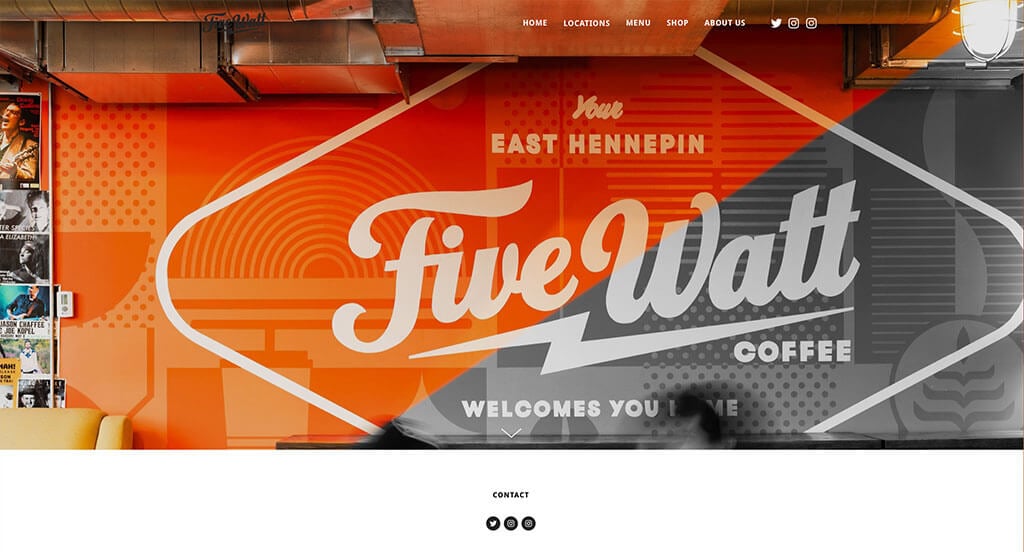
This is a great website design idea for a coffee seller to check out when looking for custom website layouts. After scrolling past the header of this coffee shop website, you’ll immediately notice the bright colors in their imagery. Their simplistic design that helps you focus on their information was another feature in this professional Coffee website we enjoyed. Five Watt Coffee had digital marketing in mind when creating the cool graphics for on their drink cans. With so many quality reasons to consider this coffee website, it’s obvious why we included it in this list of the best sites!
23. Common Grounds Waco
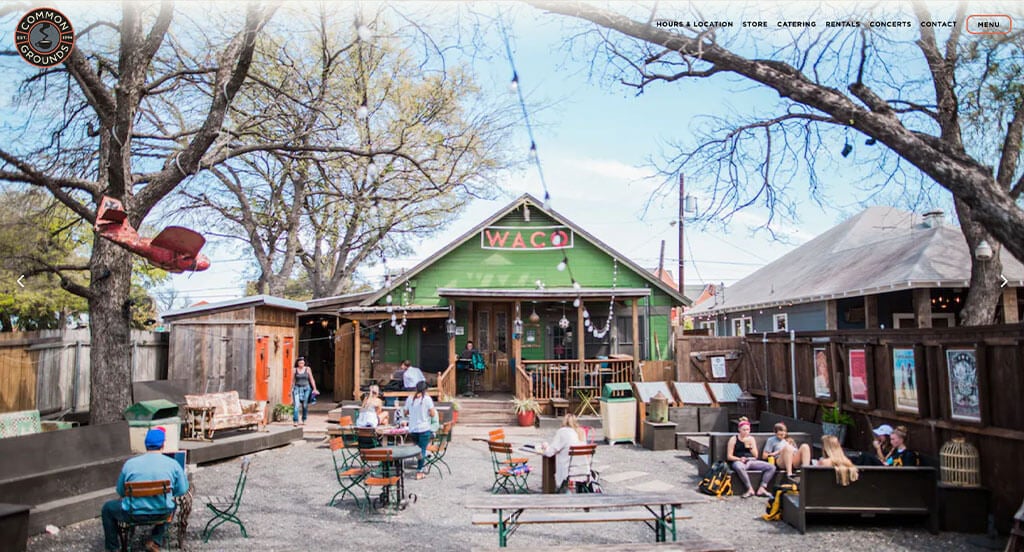
The website of Common Ground Waco ranked because it’s one of the nicer coffee websites we reviewed. The pleasing logo design was likely the most impactful feature in the homepage of Common Ground Waco. Their well-labeled navigation bar was refreshing for a unique website. Their schedule for concerts at their shop helped make this one of the best coffee websites we considered. What a great website to review when designing your next website!
24. The Elk
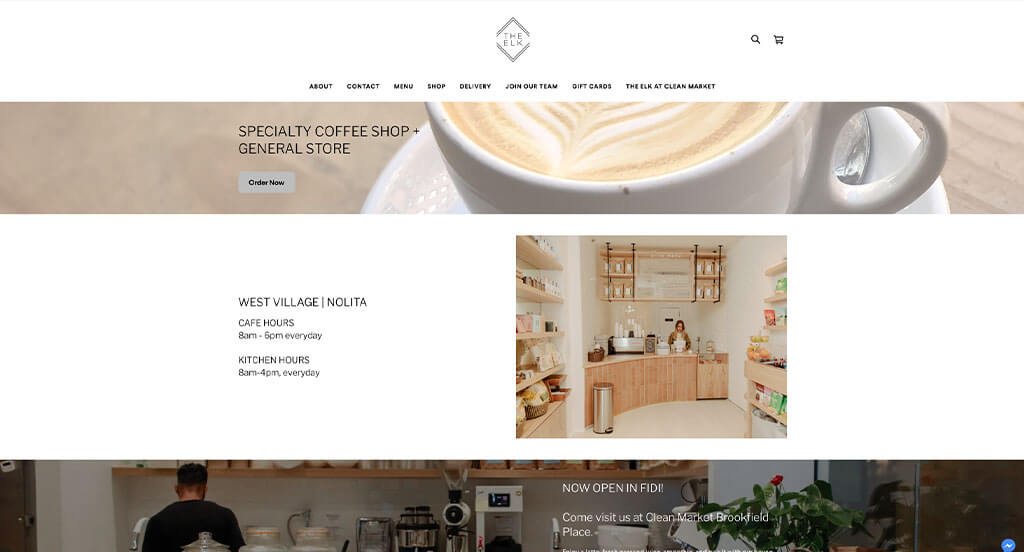
This is a good example of a website for a coffee shop to see when looking for custom web design layout ideas. The basic color palette was likely the most impactful feature in the homepage of this website. This custom coffee store website also does a good job with their high-quality images. They clearly had internet marketing in mind when designing the logically organized information for their website. If you are looking for template examples for your next coffee site, give some thought to this one.
25. The Missing Bean
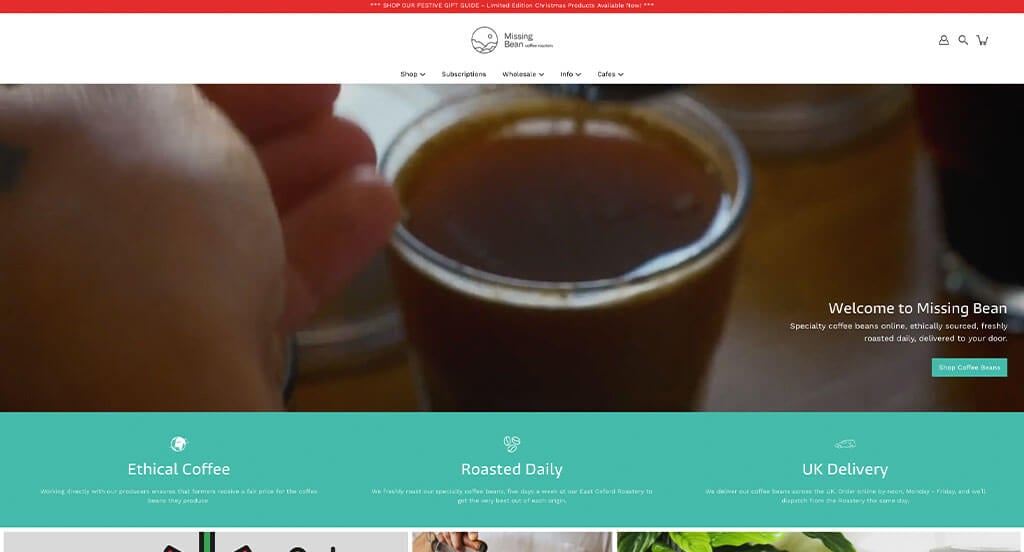
The black, white and blue color scheme seen in this coffee site stood out to us because it catches the eyes of viewers. The large imagery was likely the most impactful feature in the homepage of this website. The creative font was a nice touch for a professional site. The Missing Bean clearly had website marketing in mind when building the interesting logo design for their company. Be sure to consider the great design of this coffee shop website when developing your next custom website.
26. City Place Cafe
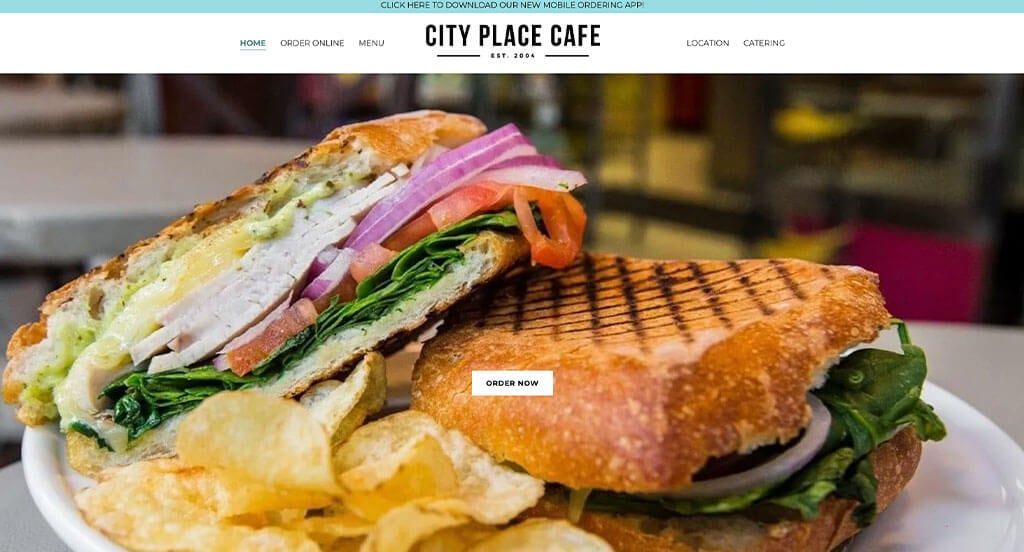
This is a good example of a web design for coffee shop to see when looking for a custom look and feel for their next site. The most attention grabbing aspect in this cafe website was definitely their display of images. Another thoughtful feature in this custom coffee website was their short and to the point paragraphs. City Place Cafe clearly had a focus on ease of use when designing the clearly labeled menu for their website. Don’t forget to check this website out while looking through our list of the best coffee shop websites!
27. Single O
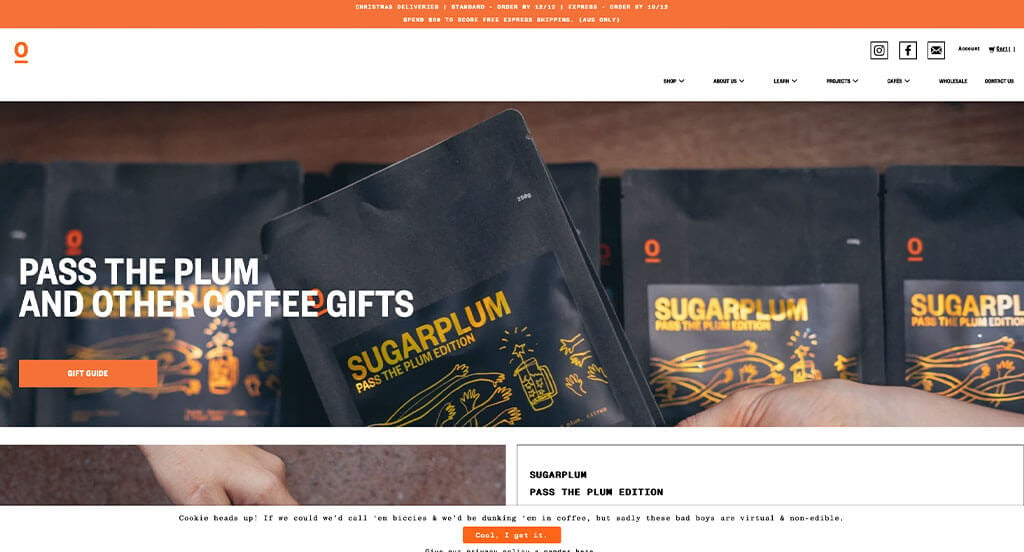
This is a great website example for coffee sellers who are looking for a custom site layout. While most coffee shop websites share this quality, we thought Single O did a nice job of choosing a color palette that matches their company. The bold font to emphasize titles was a unique choice for a professional coffee store site. They clearly had a focus on internet marketing when choosing a variety of products to include in their website. Give some thought to the great design of this coffee website when building out your next website.
28. Felix Roasting Co.
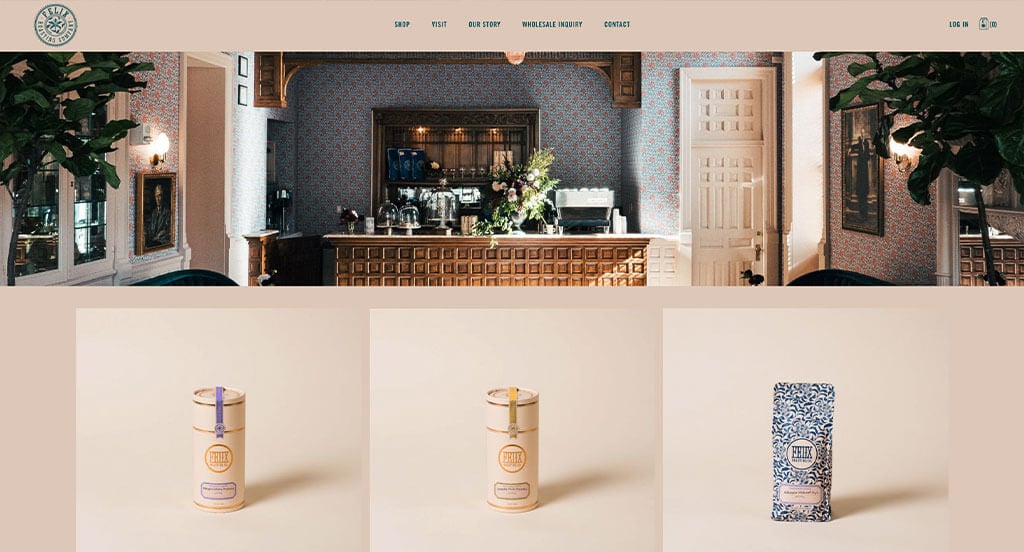
We appreciated how this coffee shop site used the colors of tan, green and white to create an attractive website layout. After scrolling past the header of this coffee store site, you’ll immediately notice their clearly labeled pricing. Another feature in this clean coffee site we liked was their unity throughout all their pages. Felix Roasting Co. clearly had digital marketing in mind when building the stunning logo for their company. For coffee stores looking for examples for their next website layout, this example will for sure be one to keep in mind.
29. Goodboybob Coffee Roasters
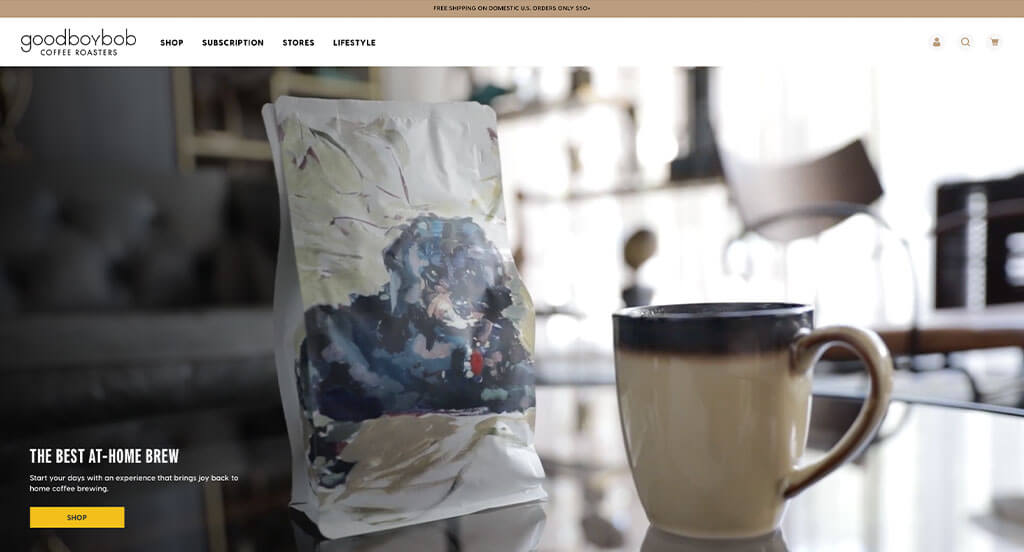
The black, white, yellow and blue colors used in this coffee website stood out to us because it’s an interesting combination that looks great together. One of the parts in this website’s homepage that caught our attention was their use of buttons to enhance usability. Their navigation bar that uses images was another unique quality in this professional coffee website we enjoyed. Goodboybob Coffee Roasters had internet marketing in mind when creating the optimized content for their website. What a great website to review when designing your next website!
Related: Rank your coffee roasting business in Google with the help of an SEO agency.
30. Buzz Coffee
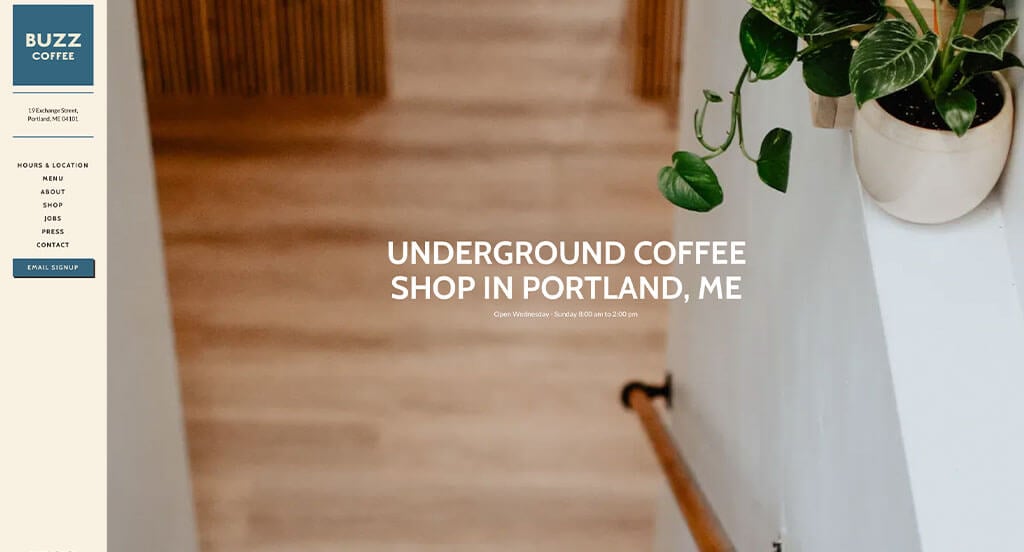
This is a good example of a website design for coffee shops to check out when looking for a professional website design. One of the homepage features in Buzz Coffee we noticed was their integration of social media because that isn’t something you find on most coffee websites. Another thoughtful quality in this creative coffee shop website was their simple contact information. Buzz Coffee clearly had a focus on ease of use when designing the domain for their website that’s similar to the company’s name. These were just a few of the numerous qualities we had to consider while we were putting together this list of top websites for coffee stores.
31. Ginger & White
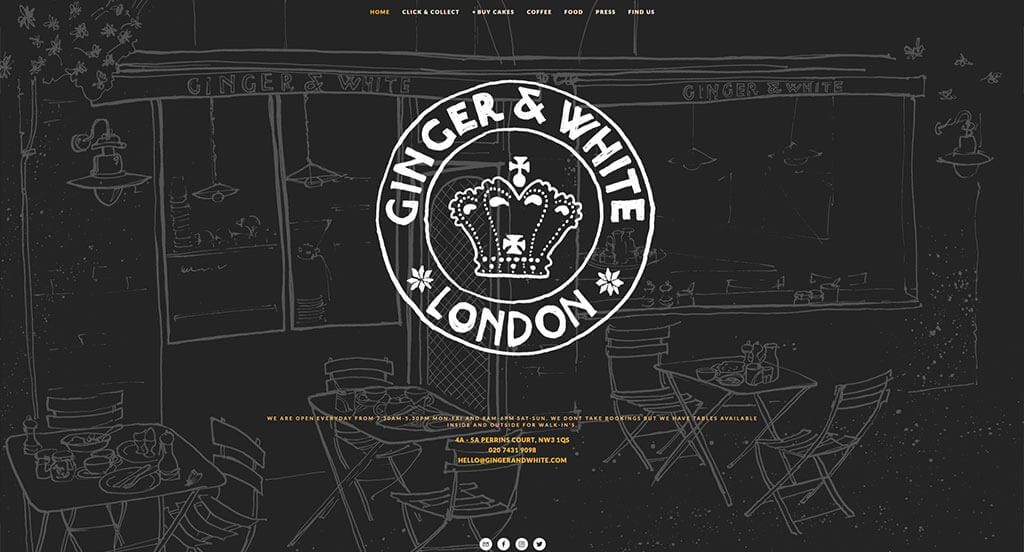
This is a great website design example for coffee shops to review when looking for a custom layout. One of the homepage features of Ginger & White we noticed was their creative background graphics because that isn’t something you find on most coffee shop websites. The inclusion of their press articles was another design quality in this professional coffee site we enjoyed. They had internet marketing in mind when designing the logo for their company. Talk about a great website to have included in this list!
32. Foxy Loxy Cafe
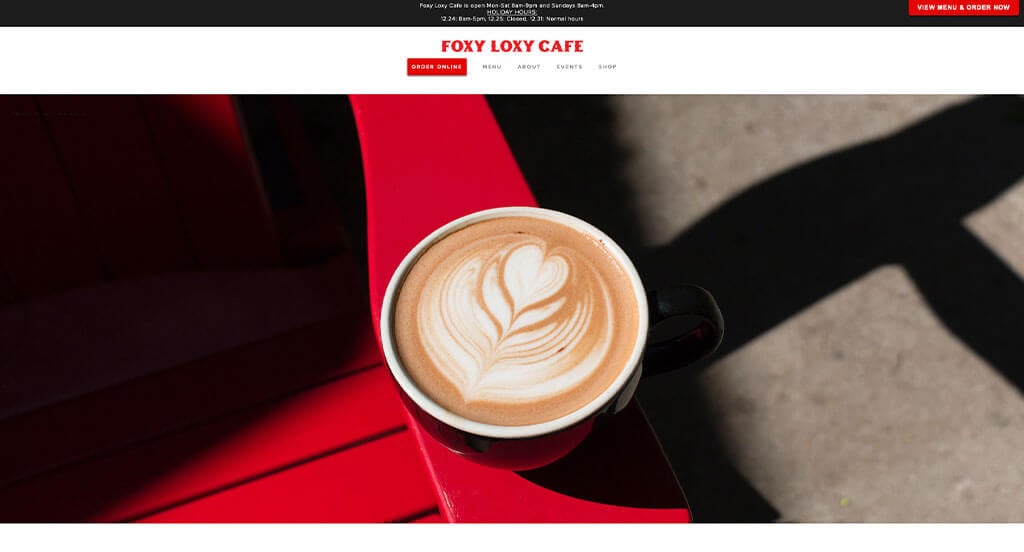
We chose Foxy Loxy Cafe because of its nicely organized coffee website that uses a white, red and black color scheme. The layout of this coffee shop website was thoughtful because their balance of text, graphics and imagery. Another design quality in this professional coffee site we enjoyed was their creative menu design. Foxy Loxy Cafe clearly had a focus on website accessibility when designing the simple order online feature for their website. Don’t forget to check this website out while looking through our list of the best coffee shop websites!
33. Roots Cafe
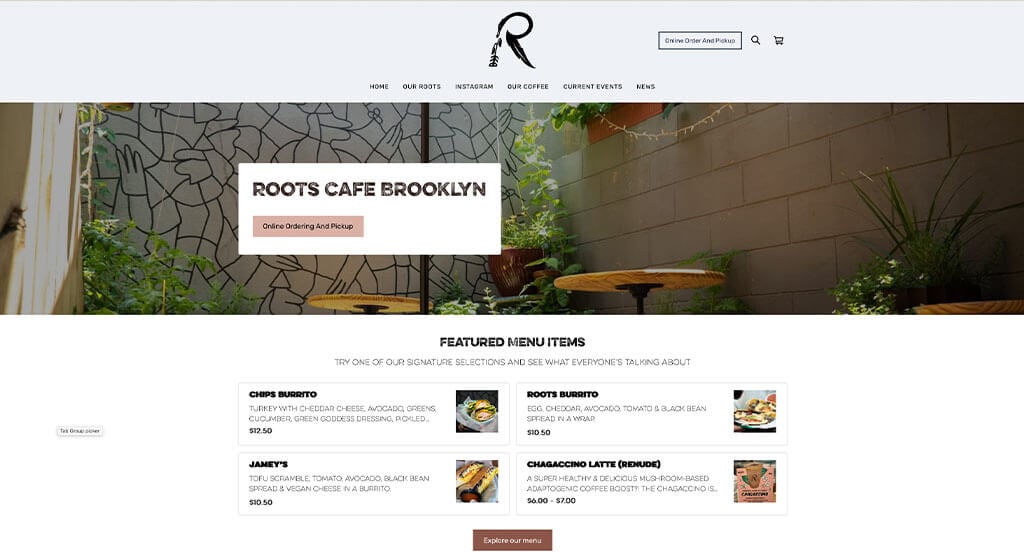
This is a good example of a website design for coffee shops who are looking for a professional layout for their next site. We thought this was a good homepage design example for coffee stores because of their thought provoking logo design. Their professional and fun text was refreshing for a custom coffee shop site. They clearly had digital marketing in mind when designing the layout for their website that was free of distractions. Any website designer making websites for coffee stores will want to consider checking this website out.
34. The WestBean Coffee Roasters
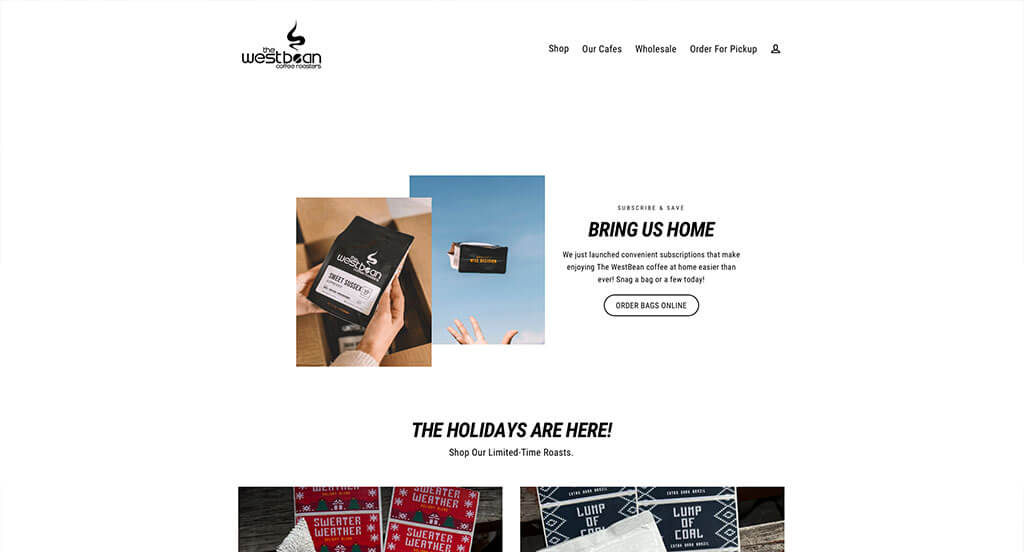
We appreciated how this coffee shop website used the colors of black and white to create a custom web design. The stunning visuals were likely the most impactful quality in the homepage of The WestBean Coffee Roasters. Another thoughtful feature in this custom coffee store site we noticed was the simple checkout process. The WestBean Coffee Roasters had website usability in mind when designing the simple navigation for their website. Be sure to consider the unique design of this coffee website when developing your next website.
35. Lula Cafe
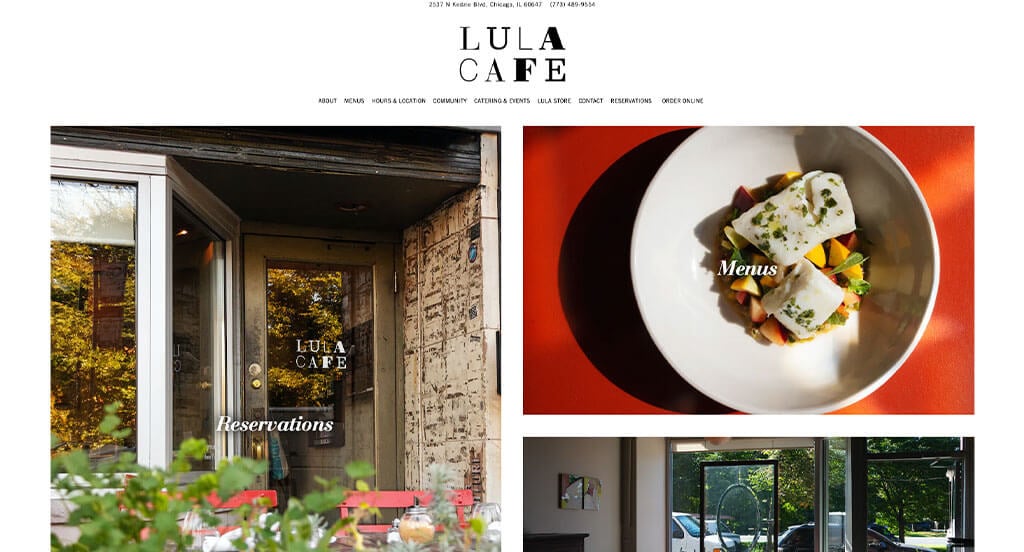
The website of Lula Cafe ranked because it’s one of the nicer coffee websites we have encountered. As you scroll through the homepage, one of the design qualities we liked was their images that guide viewers to other parts of their site. Another feature in this clean cafe website was their menus for different times of the day. Lula Cafe clearly had a focus on website usability when building the buttons for simple navigation throughout their website. For coffee shops looking for examples for their next website layout, this design example will absolutely be one to consider.
36. Souvenir Coffee
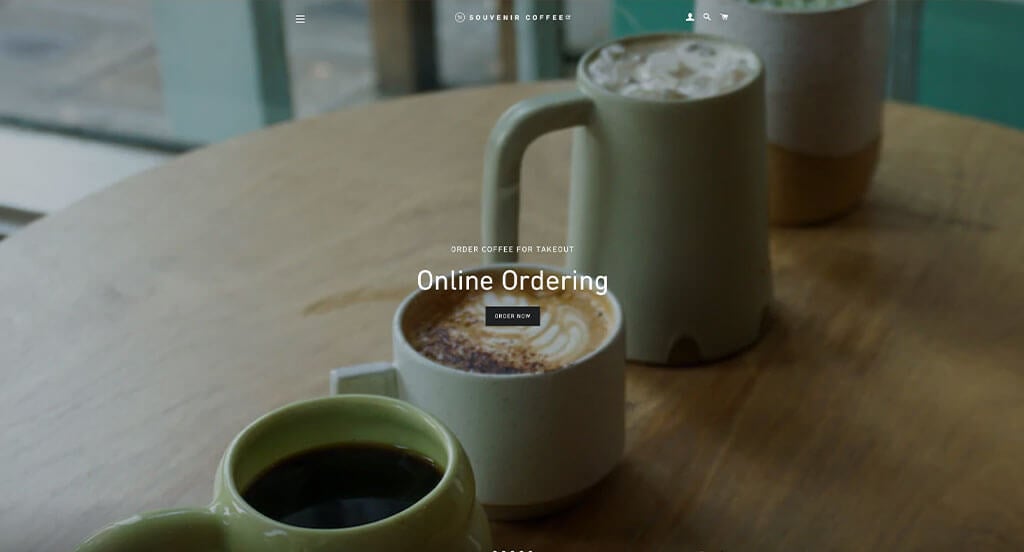
This is a creative website design example for a coffee shop looking to build their next professional website. The logo design that was used throughout the whole site was definitely the most impactful quality in the homepage of this website. Another thoughtful feature in this custom coffee store website we noticed was the use of different sized fonts to emphasize a statement. Souvenir Coffee had ease of use in mind when adding the informational blog into their website. Don’t scroll past this website when considering design ideas for your next coffee website!
37. Sextant Coffee Roasters
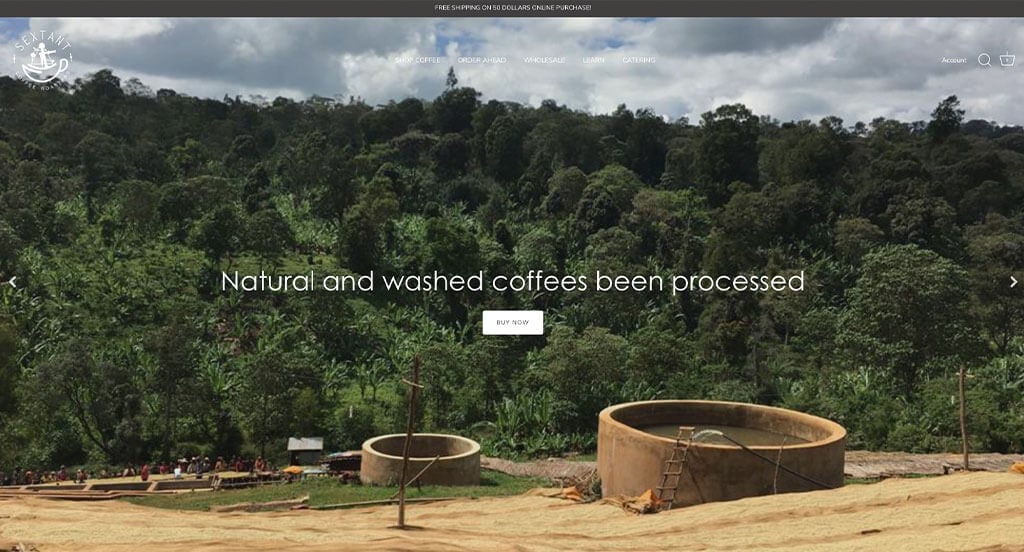
We appreciated how this coffee shop site used the colors of black, gray and white to make an attractive website layout. As you scroll through the homepage of this website, one of the qualities you’ll notice right away is the clearly labeled menu. Another thoughtful feature in this clean coffee store website was their unique logo that matches their company’s name. From a marketing point of view, we really liked the way they utilized a variation of products. Don’t skip past this website when considering design ideas for your next coffee shop website!
38. The Boy & The Bear Coffee Roasters
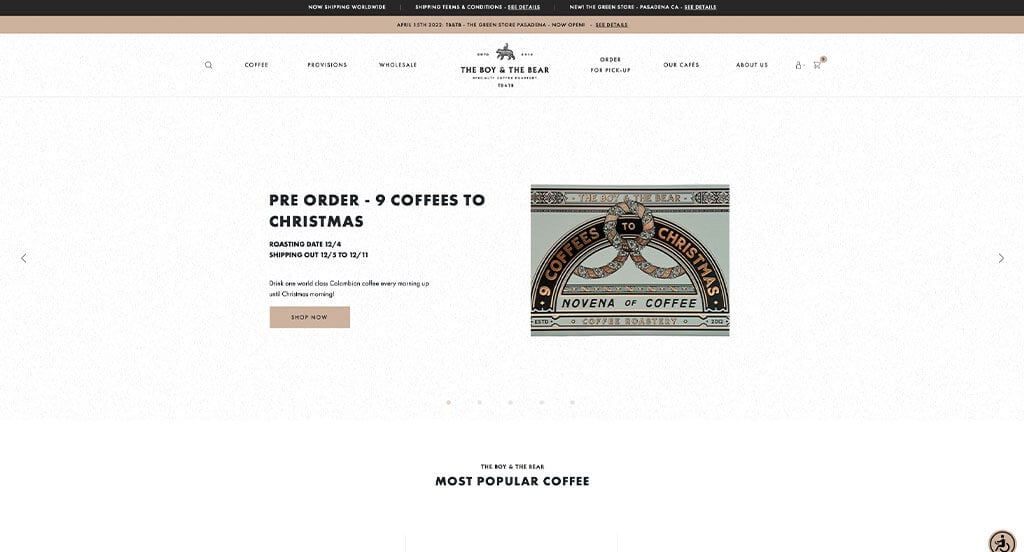
The black, white and tan colors used in this coffee site stood out to us because it creates a relaxing design. The part of this website’s homepage that caught our attention was definitely the lightly textured backgrounds. Another thoughtful feature in this custom coffee shop site was the graphics that match their company. They clearly had a focus on website usability when designing the domain for their website that matches their company’s name. Give some thought to the one-of-a-kind design of this coffee website when developing your next website.
39. Coffee Bar
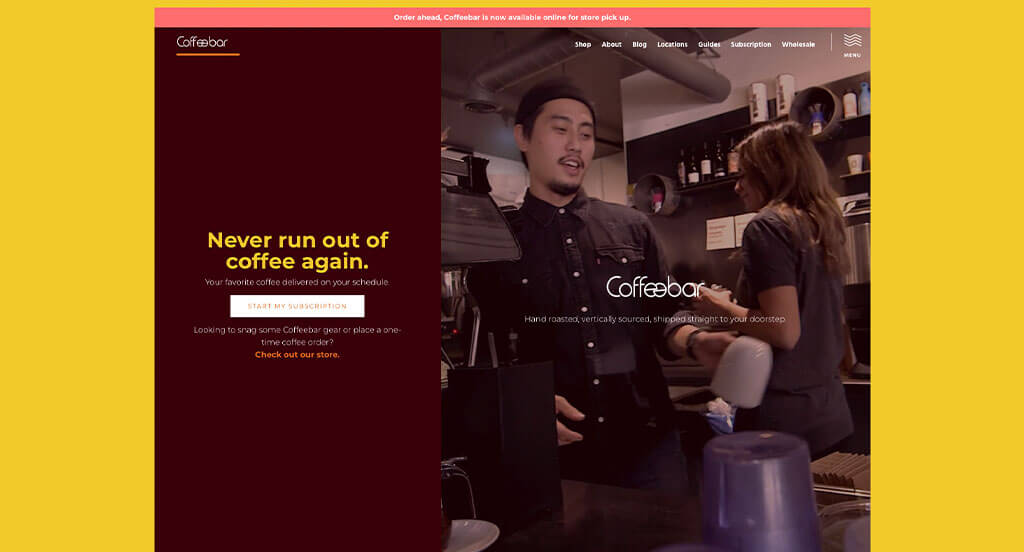
Coffee Bar has a well-designed coffee store website that uses a brown, yellow, orange, cream and white color palette. The look and feel of the homepage of this coffee website caught our attention because of the subtle animations. This custom coffee store website also does a good job with the different sized fonts to emphasize a statement. Coffee Bar clearly had a focus on internet marketing when building the stunning template for their website. Talk about a great website to have included in this list!
40. Summer Moon Coffee
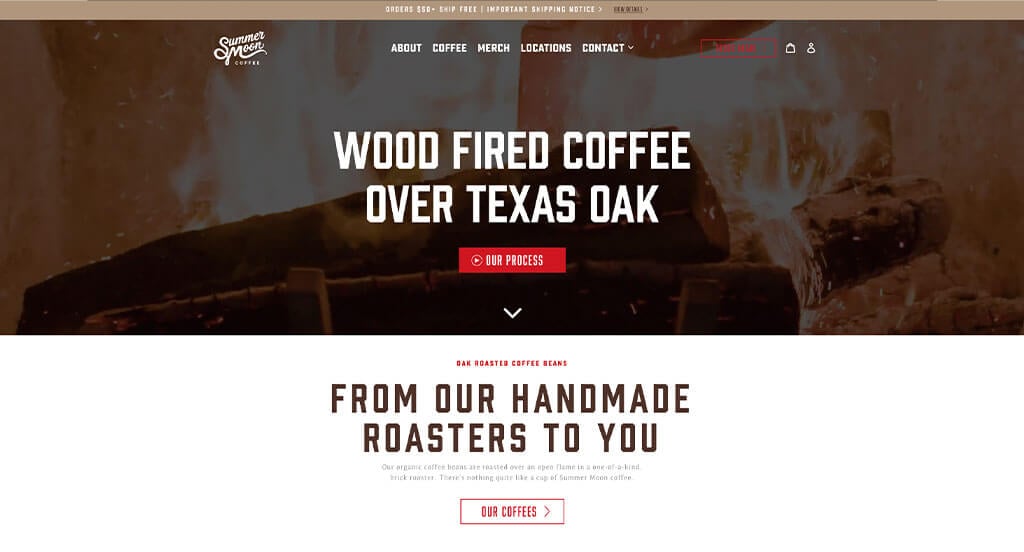
This is a good website example of a website design for coffee shops who are looking for a custom site layout idea. Our web designers thought this website was a good example for coffee stores because of their design that feels authentic to their company. This professional coffee site also does a good job with the captivating fonts. From a marketing perspective, for a coffee store website we really liked the way they utilized a well-labeled navigation bar. Be sure to consider the unique design of this coffee shop website when developing your next custom website.
41. The Sweet Spot
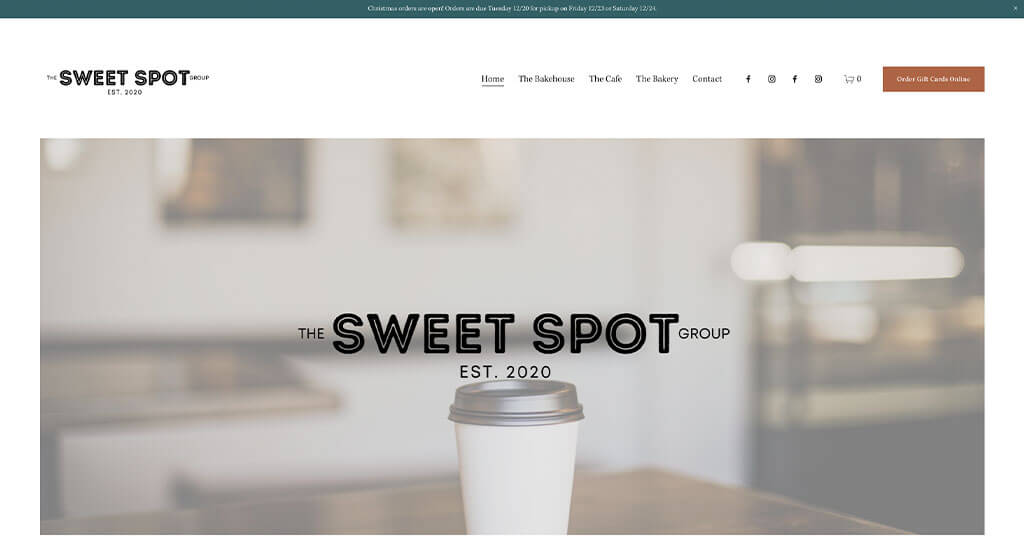
This is a great coffee shop web design example for someone who is looking to develop a professional website. The beautiful graphics were probably the most impactful quality in the homepage of The Sweet Spot. Another feature in this creative coffee store website was their incorporation of social media. They clearly had a focus on ease of use when building the simple contact information for their website. With so many quality reasons to consider this coffee website, it’s obvious why we included it in this list of the best sites!
42. The Local Restaurant & Cafe
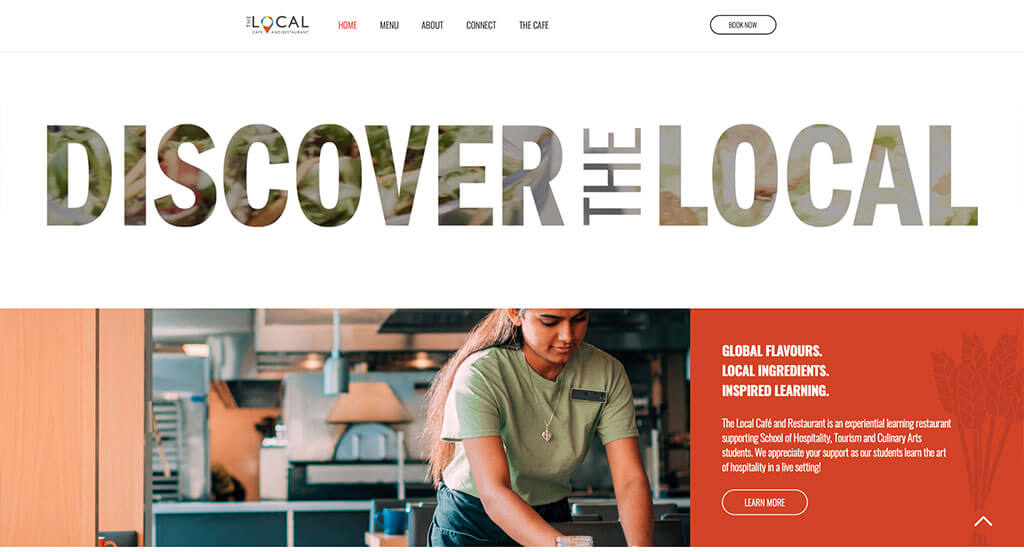
The white, gray, black and red colors seen in this coffee website stood out to us because it creates a nice accent. We thought this was a good example of a homepage layout for coffee shop because of the logically organized content. The layout with a good balance of white space was another thoughtful feature in this custom coffee site we enjoyed. The Local Restaurant & Cafe had website marketing in mind when designing the different fonts for their website. Any website designer making websites for coffee stores will want to consider checking this website out.
43. Vice City Bean
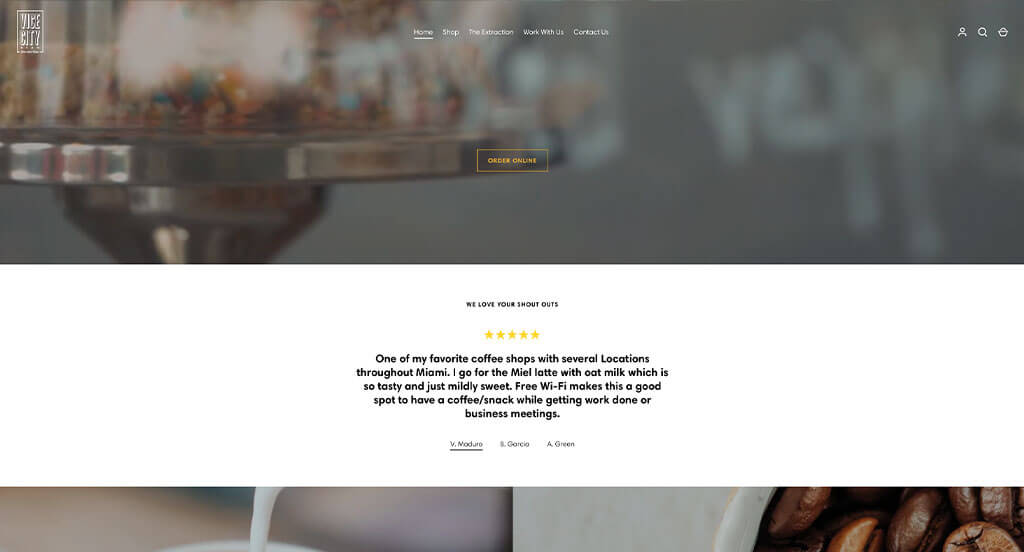
This is a great web design example for coffee shops who are looking for a professional layout for their next site. Of all the professional coffee store websites we reviewed, one of the features in this custom website we liked was their balance of text, graphics and images. Another design quality in this custom coffee site we noticed was the large display of customer reviews. Vice City Bean clearly had a focus on internet marketing when designing the domain for their website that matches their company’s name. Don’t scroll past this website when considering design ideas for your next coffee shop website!
44. Campos Coffee
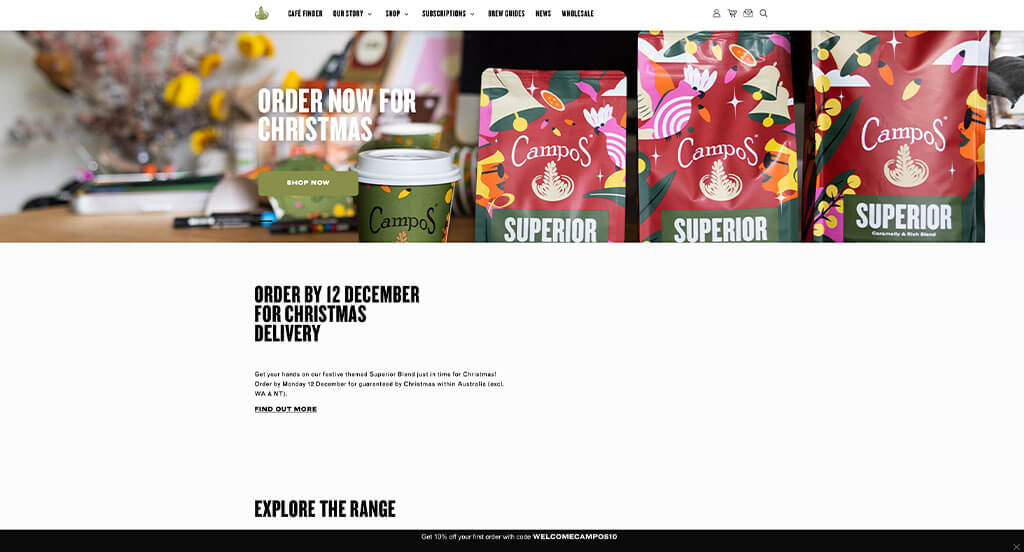
This is a good example of a coffee shop website design to check out while looking for a professional website layout idea. Of all the custom coffee store websites we reviewed, one of the features in this custom website we liked was their thoughtful logo design. The green accent that wasn’t overpowering was another design quality in this professional coffee website we enjoyed. Campos Coffee clearly had a focus on website accessibility when creating the navigation bar for their website with organized categories. What a great website to review when building out your next website!
45. Cafe Umbria
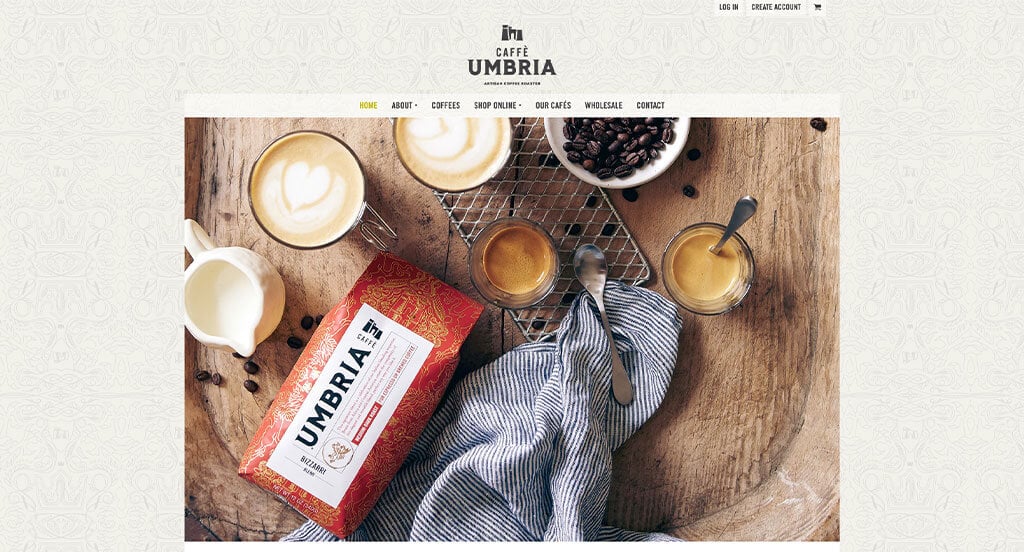
This is a great website example for coffee stores to check out when looking for a custom web design. The most refreshing part in this coffee shop website was the graphic patterns used for backgrounds. The short paragraphs about each coffee blend was another design quality in this professional coffee store site we enjoyed. The simple checkout process helped make this one of the top coffee shop websites we considered. Give some thought to the great design of this coffee website when building out your next website.
46. Tallio’s Coffee & Tea
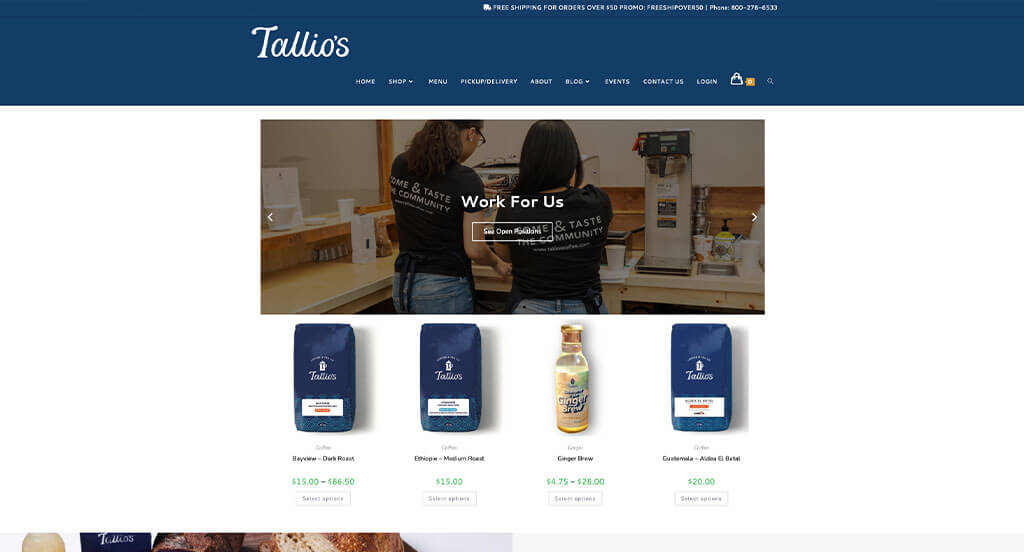
The white, black and blue color scheme used in this coffee site stood out to us because it creates a simple and enjoyable feel. After scrolling past the navigation of this coffee shop site, you’ll immediately notice the logical structure to their content. Another design quality in this clean coffee website we liked was the layout that was free of distractions. They clearly had a focus on internet marketing when utilizing color blocks to break up content within their website. You won’t be disappointed after reviewing this website for design ideas for your next website!
47. Little Collins
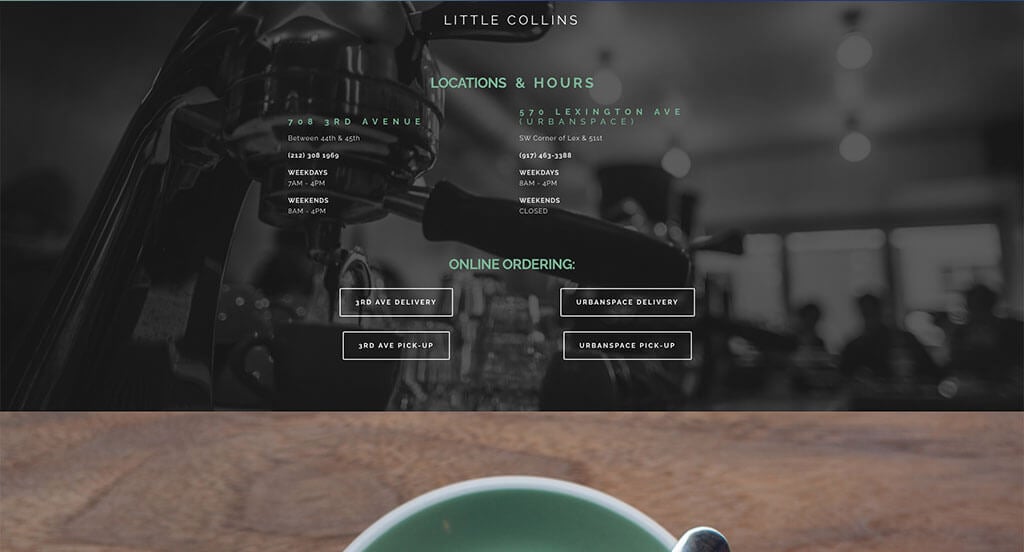
This is a great website design example for a coffee shop that is looking to get inspired for their next custom layout. After scrolling past the header of this coffee store site, you’ll immediately notice their adorable mascot. Another feature in this custom coffee site we enjoyed was their subtle animations. They clearly had conversions in mind when designing the refreshing color palette for their website. For coffee shops looking for examples for their next website layout, this example will for sure be one to consider.
48. Hilltop Coffee & Kitchen

This is a good example of a website design for coffee sellers to check out when looking for a professional website layout idea for their next site. As you scroll through the homepage of the website, one of the design qualities you’ll see is their creative logo design. Another thoughtful quality we noticed in this custom coffee shop site was their use of repetitive swirling design throughout the pages. They clearly had a focus on digital marketing when designing the buttons to enhance usability throughout their website. Don’t skip past this website when considering design ideas for your next coffee website!
49. Lucky Goat Coffee
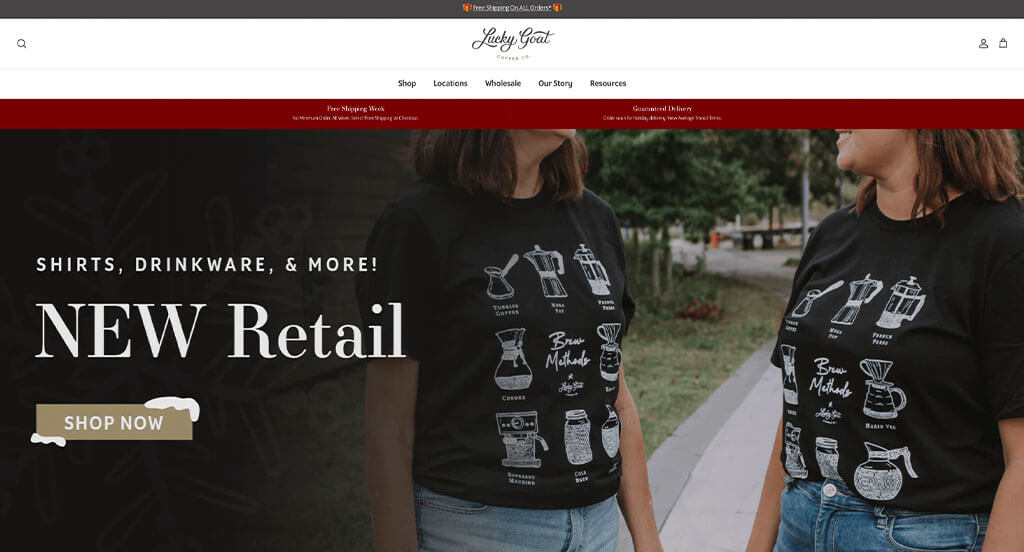
The red, white, gray and black color palette used in this custom coffee site stood out to us because it allows the images to be the focus of the page. Of all the professional coffee shop websites we reviewed, one of the features in this custom website we liked was their clearly labeled pricing. The buttons for simple navigation was a great choice for a professional coffee site. They clearly had a focus on digital marketing when creating the domain for their website that matches the company’s name. With so many quality reasons to consider this coffee store website, it’s no wonder we included it in this list of the best sites!
How to Create an Outstanding Coffee Shop Website
Are you in the process of building a new website for your coffee shop? How exciting!
Let’s go through some of the most essential steps in constructing a new, or redesigning an existing, coffee shop website.
If you already have a domain name, hosting service, and website platform selected, feel free to skip the first few sections!
1.) Acquiring a Domain Name
Choosing the right domain name for your coffee website is a crucial step in establishing your coffee shop’s online presence. It serves as the address that visitors will use to access your coffee website, and it plays a significant role in branding and recognition of your shop.
Here’s a step-by-step process to help you select the perfect domain name:
- Generate Ideas: Start by brainstorming ideas for your domain name, considering your coffee shop’s name, the type of coffee you offer, and your location.
- Simplicity: Aim to keep your domain name simple, easy to spell, and pronounce. Avoid using complicated words, hyphens, or numbers.
- Consistency: If your coffee shop has an established brand name, it’s generally a good idea to include it in your domain name. For example, if your business name is Big Al’s Coffee Buzz, avoid registering a domain name like 920CoffeeStore.net.
- Availability: Before proceeding, check the availability of your desired domain names. Most common domain names have already been taken. If that’s the case, see if your desired domain name is unused and available for purchase. However, avoid spending excessive money on acquiring a domain name.
- Domain Extensions: Consider which domain name extension best suits your website’s purpose. While .com is the most common and widely recognized extension, there are other options available, such as .net, .org, or industry-specific extensions like .coffee.
- Legal Considerations: Before registering your domain name, it’s crucial to conduct a trademark search to ensure that your chosen name doesn’t infringe upon someone else’s intellectual property. For instance, avoid registering a domain name that includes another coffee shop’s business name or the name of a popular coffee equipment company.
- Register the Domain: Once you’ve settled on an available domain name, it’s time to register it through a reputable domain registrar. As a digital agency, we’ve assisted numerous clients in managing domain names through various domain registrar portals. We’ve found GoDaddy and Namecheap to be the most user-friendly domain registrars.
2.) Selecting a Website Platform
After figuring out your domain name, the next step is selecting a website platform for your next coffee website.
Most coffee shops are going to develop content-based websites with hours of operation, daily / weekly specials, location maps, and contact forms to drive conversions.
You’ll typically only see coffee websites adding ecommerce if they are selling coffee beans, drinkware, or brewing equipment online. This is a competitive space though.
For Content Websites:
Most coffee shops will find WordPress to be an excellent platform choice. However, there are alternative options like Wix and other hosted website builders.
- WordPress: WordPress is a versatile and widely used content management system (CMS) that offers immense flexibility and customization options. It caters to all types of coffee shop websites, from simple sites to more advanced ones that integrate online ordering through third-party plugins. With a wide range of coffee-themed themes and useful plugins available, WordPress allows you to create a highly personalized website tailored to your coffee shop. It’s an excellent choice if you value control and want the ability to expand your website’s functionality over time. While there is a hosted version of WordPress, most users install the open-source version on a web hosting account.
- Wix: The Wix platform offers many of the same page building features and is also a hosted solution. We have worked on coffee shop websites built on Wix, and it’s a capable page builder, so we confidently recommend it. With Wix, you won’t need a separate web hosting service.
For Ecommerce Websites:
If your coffee business sells products online, you’ll likely be satisfied with either WooCommerce or Shopify.
- WooCommerce: If you plan to build an online coffee store using WordPress, WooCommerce is the ideal ecommerce plugin to install. It seamlessly integrates with WordPress, allowing you to add ecommerce functionality to your existing coffee website. WooCommerce offers a wide range of extensions, payment gateways, and inventory management tools, making it a perfect choice for coffee businesses looking to sell online.
- Shopify: The Shopify platform is a leading ecommerce solution that provides everything you need to create and manage an online coffee business. It is a hosted ecommerce platform, eliminating the need to find a separate web hosting service. Similar to other ecommerce solutions, it offers a user-friendly interface, customizable themes, built-in security, and various features for inventory management, payments, and shipping.
Web Hosting Requirements
If you opt for platforms like WordPress or WooCommerce, you’ll need to find a web hosting service.
As a shameless suggestion, we often recommend our own web hosting service because of its excellent compatibility with WordPress websites. For recommendations of reliable web hosting services from other hosting companies, consider the following:
- WP Engine: This is one of our preferred web hosting services for coffee companies. WP Engine offers a user-friendly control panel that simplifies the creation of staging websites. Their backup process is seamless. The only downside we’ve encountered is the limits they impose on PHP max_execution_time. Additionally, their pricing can increase rapidly if you require upgraded services.
- SiteGround: We have always had a positive experience with SiteGround. Their live chat and email support are excellent compared to more well-known hosting firms. We have never had to wait long to get in touch with someone, and the first person we interacted with typically resolved the issue. Their backup tools are very user-friendly, and they offer reasonable pricing for coffee shops.
- Digital Ocean: This is a great option for cloud hosting but may be too advanced for most coffee shop websites. We have never encountered issues with the Digital Ocean cloud network, unlike other cloud networks we’ve tried. Cloud hosting can be costly when factoring in droplet (server instance) costs, operating system, control panel, server software, offsite backup, and server management fees. For server administration recommendations, check out AdminGeekZ.
3.) Choosing a Website Template
Most coffee shops opt to purchase and customize a third-party website template as it significantly reduces web development costs and turnaround time. However, if your coffee shop prefers a custom design, you can always hire a custom web developer or custom ecommerce developer to create a theme from scratch.
For the purpose of setting up a coffee website, let’s focus on suggestions for finding pre-built website templates! Here are some links to the main theme marketplaces to consider:
WordPress Coffee Themes
You can find free themes at wordpress.org, or explore coffee-inspired templates on ThemeForest.
Amaya – Themeforest
$79
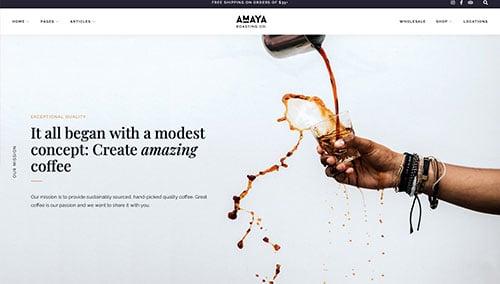
Corretto – Themeforest
$69
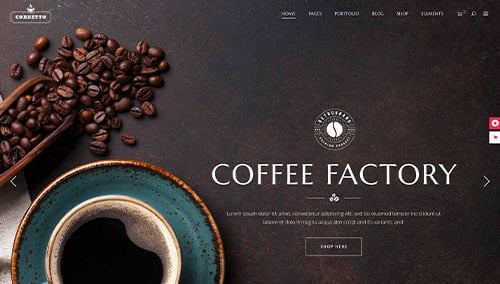
Bouffe – Themeforest
$59
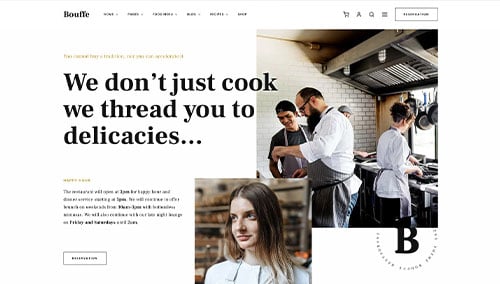
Barista – Themeforest
$79
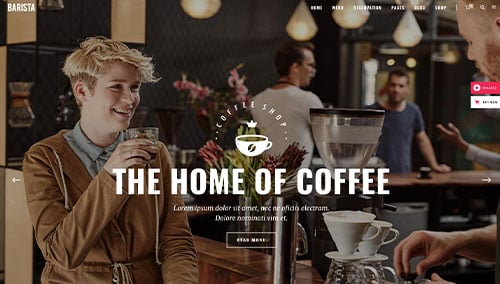
WooCommerce Coffee Themes
You’ll find numerous ecommerce coffee themes for WooCommerce on ThemeForest.
Larcorso – Themeforest
$110
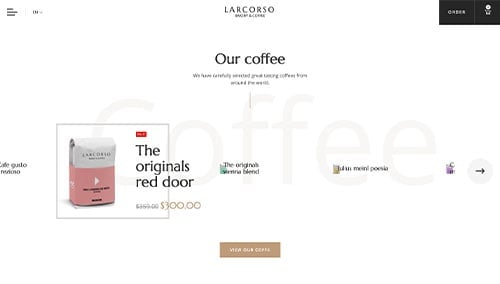
Bakerfresh – Themeforest
$59
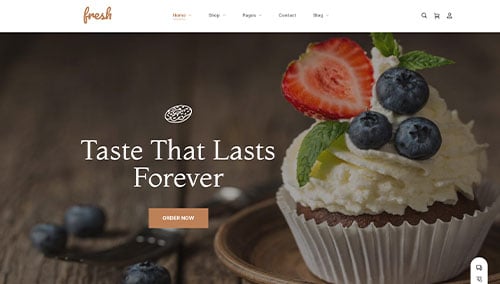
Shopify Coffee Themes
You can find free and paid themes at themes.shopify.com, or explore options through marketplaces like ThemeForest.
Coffee – Themeforest
$29

Kofi – Themeforest
$39
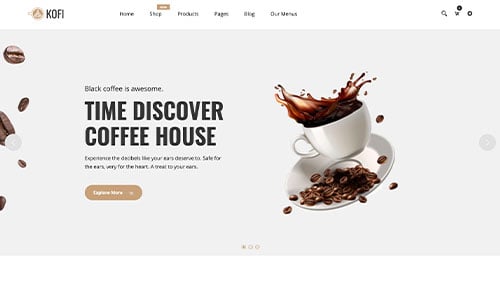
Wix Coffee Themes
You can find free and paid themes in their marketplace at wix.com, some of which are great for coffee shops.
4.) Crafting Content & Adding Visuals
Now that you have your domain name, website platform, and theme in place, it’s time to start developing content for your coffee website!
There are several tips you can follow to create engaging and effective website copy. Let’s explore a few:
- Know your target audience: Before writing a single word, gain a clear understanding of your target audience. Define their demographics, preferences, and needs. Tailor your content to address their desires, provide value, and resonate with them. This will help ensure your coffee-related website ranks well in search engine results for relevant queries.
- Establish key messages: Determine the main messages you want to convey through your website content. These messages should align with your brand, highlight your unique selling points, and clearly communicate the benefits of your coffee products or services.
- Keep it concise and scannable: Online readers tend to scan content, so make sure your writing is concise and easy to skim. Use short paragraphs, bullet points, subheadings, and bold text to break up the content and enhance readability.
- Create compelling headlines: Craft attention-grabbing headlines that immediately convey the value and relevance of your coffee business. Well-crafted headlines can entice visitors to explore your website further and discover more about what you offer.
- Strategically incorporate keywords: Conduct research on relevant keywords and incorporate them naturally throughout your content. This can improve the visibility of your coffee website in search engine rankings. However, avoid keyword stuffing, as it can negatively impact readability and user experience. Tools like Ahrefs or Semrush can assist with keyword research.
- Maintain a conversational tone: Write in a conversational manner that resonates with your coffee audience. Avoid jargon or overly technical language unless your target audience specifically requires it. For example, you might not need to explain every detail of coffee bean roasting processes unless it’s crucial to your audience’s understanding. Engage your readers by addressing them directly and adopting a friendly, approachable style.
- Edit and proofread: Always edit and proofread your coffee content before publishing. Check for grammar, spelling, and punctuation errors. Ensure the flow of your content is smooth and logical, and that it aligns with your brand voice and style guidelines. Tools like Grammarly can be helpful in this process!
- Utilize ChatGPT for assistance: If you encounter difficulties generating ideas or need help refining the content on your coffee website, consider leveraging AI tools like ChatGPT.
In addition to well-crafted text, it’s important to enhance your content with relevant and high-quality images. Consider the following tips:
- Choose high-quality images: Opt for visually appealing and well-composed high-resolution images. Blurry or pixelated images can detract from the overall quality of your coffee website.
- Ensure relevance: Select images that are relevant to your content and help visually convey your message. The images you choose for your coffee shop should complement the text and provide additional context or visual interest.
- Explore stock photo resources: Utilize reputable stock photo websites like Unsplash, Pixabay, or Shutterstock to find a wide range of professional-quality coffee-related images that align with your theme. Be mindful of licensing requirements and provide appropriate attribution as necessary.
- Customize images when possible: If you have the skills or resources, consider customizing or branding images to align with your coffee brand. This can contribute to a cohesive visual experience for your visitors. Tools like Adobe Photoshop or Canva can be helpful for this purpose.
- Optimize image file sizes: Compress images to optimize their file sizes without compromising quality. Large image files can slow down the loading speed of your coffee website, negatively affecting user experience and SEO. Tools like TinyPNG can assist with this process.
5.) Activities After Website Launch
Once you have built and launched your coffee website, there are several important tasks and services to consider to maximize its effectiveness. Here are some basic suggestions to help you navigate post-launch activities:
- Search Engine Optimization (SEO): Implementing SEO strategies is crucial to improving the visibility of your coffee shop in local search results. Conduct keyword research, optimize your content, and ensure your website has a solid internal linking structure. Regularly update and create fresh, high-quality content to attract organic traffic. Consider hiring our SEO team or exploring third-party providers like The HOTH for assistance.
- Paid Advertising: For quicker traffic generation, consider utilizing paid advertising platforms like Google Ads or Facebook Ads to drive targeted visitors to your coffee business. You can hire our PPC management services or find skilled professionals on websites like Mayple.
- Conversion Rate Optimization (CRO): Analyze the performance and user behavior on your coffee website using tools like Google Analytics. Identify areas where users may drop off or encounter barriers to conversion. Conduct A/B testing with tools like VWO to make data-driven changes and improve the conversion rates and overall user experience of your coffee website.
- Website Security: Safeguard your coffee website from malware and other threats. Implement robust security measures such as SSL certificates, web application firewalls (e.g., Sucuri), and regular backups. Keep your CMS, plugins, and themes up to date to minimize vulnerabilities. Monitor your website for any potential security risks and promptly address any issues. It’s also advisable to monitor website uptime using a service like UptimeRobot.
- Website Maintenance: Regularly maintain your coffee website to ensure optimal performance. If you are using WordPress, this includes updating plugins and themes, monitoring website speed and performance, and resolving any broken links or errors. Consider hiring our website maintenance services or hiring a freelancer from Upwork. Regularly backup your coffee website to protect against data loss or technical issues.
- User Feedback and Testing: Actively seek user feedback to understand their experiences and identify areas for improvement. Implement user testing and gather insights on how users interact with your coffee website. Use this feedback to make iterative enhancements and continuously optimize the user experience.
- Content Updates: Keep your website content fresh and up to date. Regularly publish new blog posts about coffee, update product or service information, and ensure that all information is accurate and relevant. Engaging and valuable coffee content not only attracts visitors but also encourages them to return and share your content with others interested in coffee.
Remember, post-launch digital marketing activities are crucial for the long-term success of your coffee website. Stay proactive, monitor performance, and adapt your strategies to achieve your business goals and meet the needs of your audience.

